Conserving the tradition of sculpting with soil: Conversations with the artisans of Sindhudurg on the CPCB immersion guidelines by Mayuri Kumbhar and Manisha Sheth
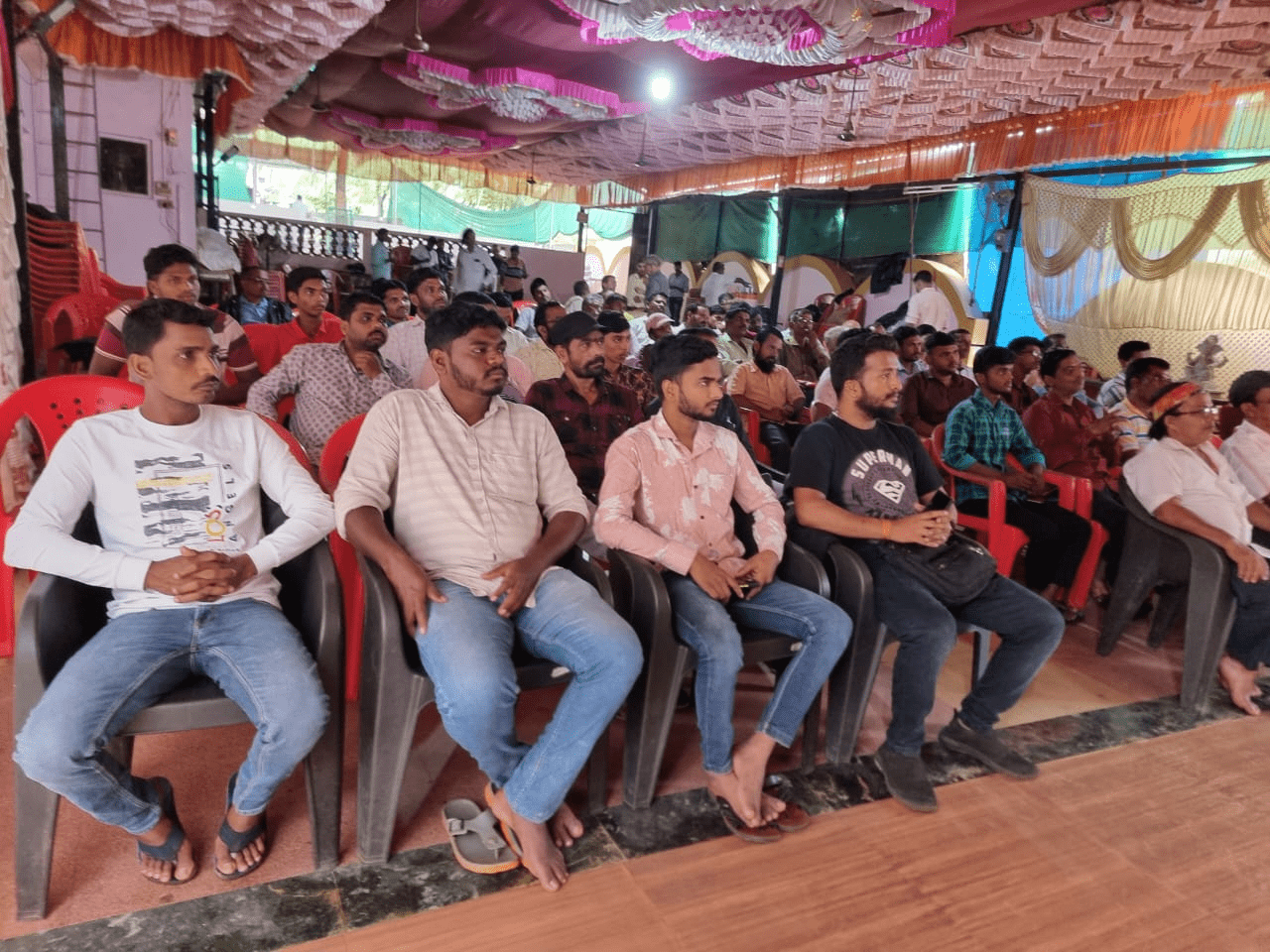
Background
The Ganesh Chaturthi festival has had a special significance in Sindhudurg districts since ancient times. People who have migrated from Konkan to Pune, Mumbai return to the Konkan especially to celebrate Ganeshotsav. According to the traditional culture here, people worship Ganesha with deep reverence.
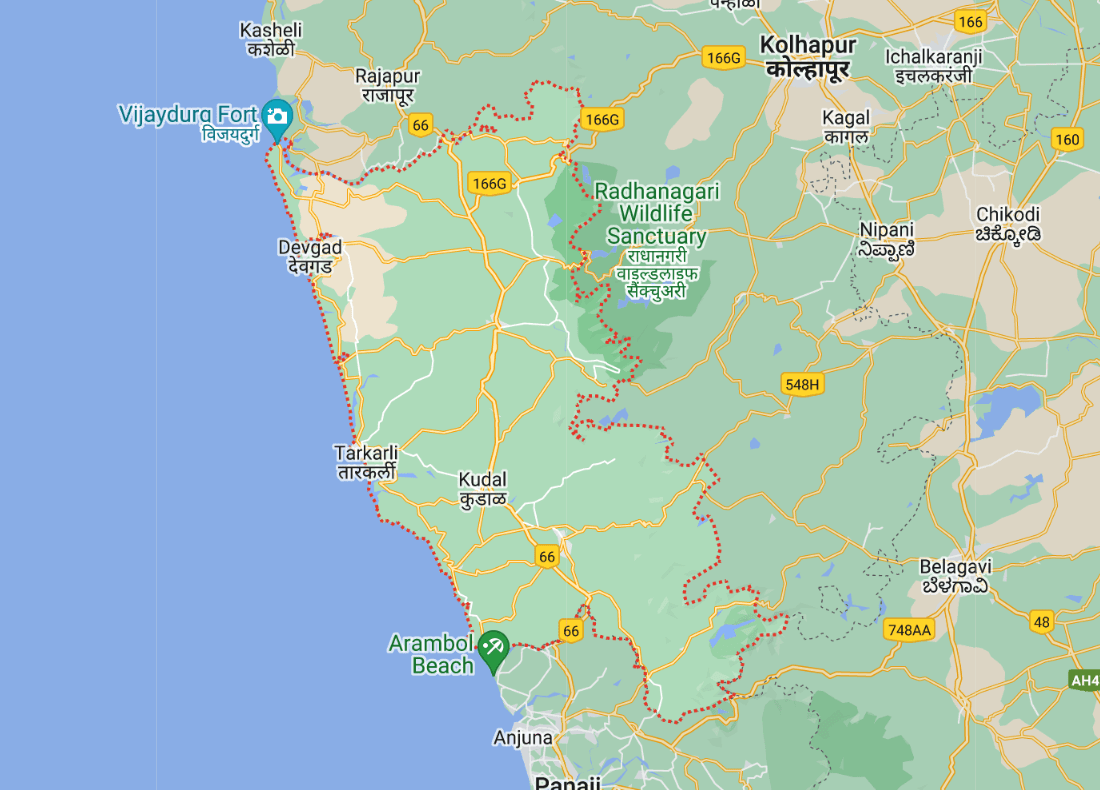
The Sindudurg district lies on the coast of Western Maharashtra, south of Mumbai and north of Goa. It has a rich natural heritage with the coastal marine ecosystems, the Western Ghats and the riverine networks that flow through it. Several wild life sanctuaries have been declared in this region, which are important habitats for species like the Indian gaur, leopard, deer, and various bird species. Several rivers flow through Sindhudurg district, including the Terekhol, Karli, and Kudal rivers. These rivers support diverse ecosystems, including mangrove forests, estuaries, and wetlands that are important for migratory birds and aquatic life.
The Central Pollution Control Boards Revised immersion guidelines are specifically aimed at protecting natural water bodies from immersion of any religious man made objects. While the artisans in Sindhudurg are still using natural and biodegradable materials, however the immersions continue to take place in natural water bodies. This survey explores the level of awareness within the artisanal community in Sindhudurg with a focus on the immersion guidelines and ban on Plaster of Paris.
The Sindhudurg district has over 150 sculpture art centres, where they make idols in different ways. In most parts of Konkan only idols made of clay are worshipped. People in this region are aware that Plaster of Paris (POP) Ganesha idols are often defaced after immersion. Due to this belief, clay idols are in great demand here, leading to larger production of these. Most idols are made by hand using a mould. Some artisans buy clay from Golvan, Sonawade to make these idols while others buy from dealers. Gavthi Mati, a type of red soil, is mainly taken from the farms. However due to overexploitation there is shortage of this soil, and artisans are turning to Shadu (clayey) soil . This Shadu soil is procured from Gujarat, Pen, Mumbai.
Some artisans are currently focusing on new experiments, with materials such as cocopeat, cow dung pulp and paper mache. Very few people seemed to be using Plaster of Paris and most of them were in favour of the ban. Immersion was preferred in flowing waters such as streams or rivers. Apparently, even consumers were not interested in using Plaster of Paris idols.
The context in Sindhudurg was very different from the picture that had emerged in the previous survey done by eCoexist Foundation in the cities of Pune and Pen. To understand the rural scenario better, we decided to do a similar survey of artisans whom we had met at Sindhudurg.
Methodology
- The eCoexist team was invited to attend a workshop of artisans held in Kasal of Sindhudurg district and interact with them courtesy Sri Ranjit Marathe of the Varad Foundation. In these preliminary interactions we realized the need for deeper conversations.
- A questionnaire was prepared based on the issues that emerged from the discussion.
- The interviews were conducted by Mayuri Kumbhar with the artisans over a phone call in the Marathi language which is native to them.
- Each sculptor was contacted individually and we walked them through the questionnaire to bring out their points of view..
- Besides the questionnaire, the conversations evolved into a free flowing discussion where further aspects emerged which also seemed relevant.
- To start with and break the ice, the conversation was about traditions and culture.
- Discussions were held with 48 artisans. This discussion was conducted over 3 to 4 days.
- Discussion sessions with artisans lasted from 10 minutes to 45 minutes.
- All discussions were audio recorded with the consent of Murtikar and their responses which was then converted into written content.
- All discussions are in Marathi language and subsequently translated to English language.
The CPCB Revised Immersion Guidelines (2020)
Prohibitions placed by way of Immersion Guidelines mainly dealt with:
-
Idols made up of Plaster of Paris (PoP) shall be banned.
-
Use of toxic and non-biodegradable chemical dyes/oil paints for painting idols should be strictly prohibited.
-
Use of Single use plastic and thermocol materials shall not be permitted
-
Restrictions on height of the idol
-
Avoid direct immersion of idols into lakes/rivers/ ponds/sea.
-
Only non-recyclable/non-biodegradable/non-recoverable materials should be disposed of in sanitary landfills
Overall Assumptions
How aware are the artisans in Sindhudurg about these guidelines? Has the ban on Plaster of Paris had any effect on them? What is their opinion on the ban and what kind of help do they need from others.
These were some of the questions we compiled to speak to the artisans. The following questions are enlisted below with a brief explanation about the assumptions we had begun with and our eventual findings.
- The tradition of sculpting a Ganesh idol is a family affair in rural India which involves men and women – gender has not been taken into consideration in this survey.
- In the Sindhudurg district artisans are scattered at distances – they may be small traditional family based craftsmen or larger businesses – the scale of production was not considered in this survey neither the location.
- We approached the survey from a neutral position – there was no attempt to convince the artisans that the ban was good or bad for them.
- We assumed that the ban would be a threat to livelihoods and so inquired whether indeed this was the case.
- While we were aware of the use of POP and Shaadu Maati ( sourced from market) – other possible materials emerged from the survey – such as Chikhan maat ( local clayey soil) and Gavthi maati ( farm soil)..
- We were aware that possibly the opinions of the artisans were influenced by the unions they belonged to.
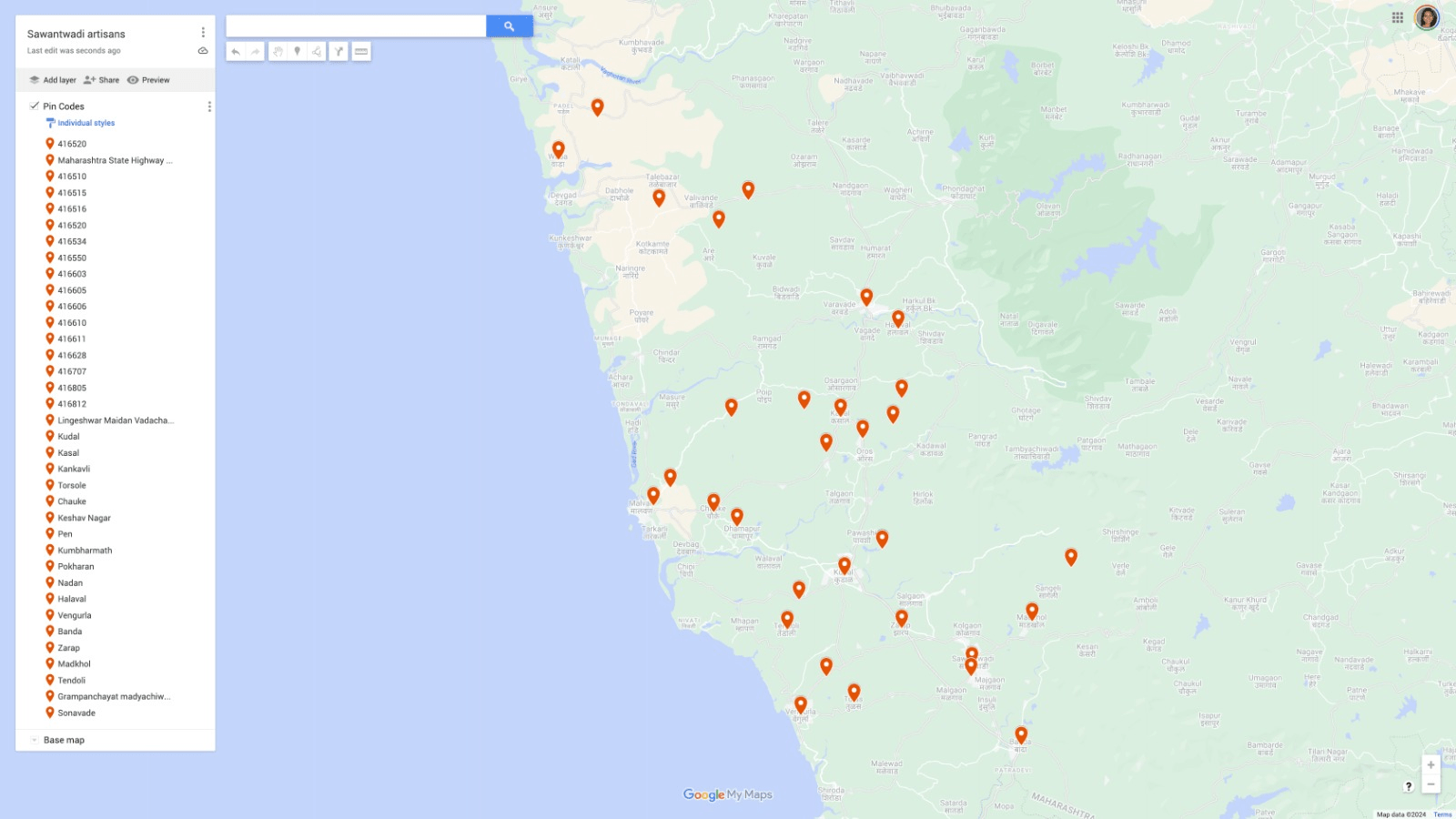
Questions
Q1: How many years have you been an artisan? (48 responses)
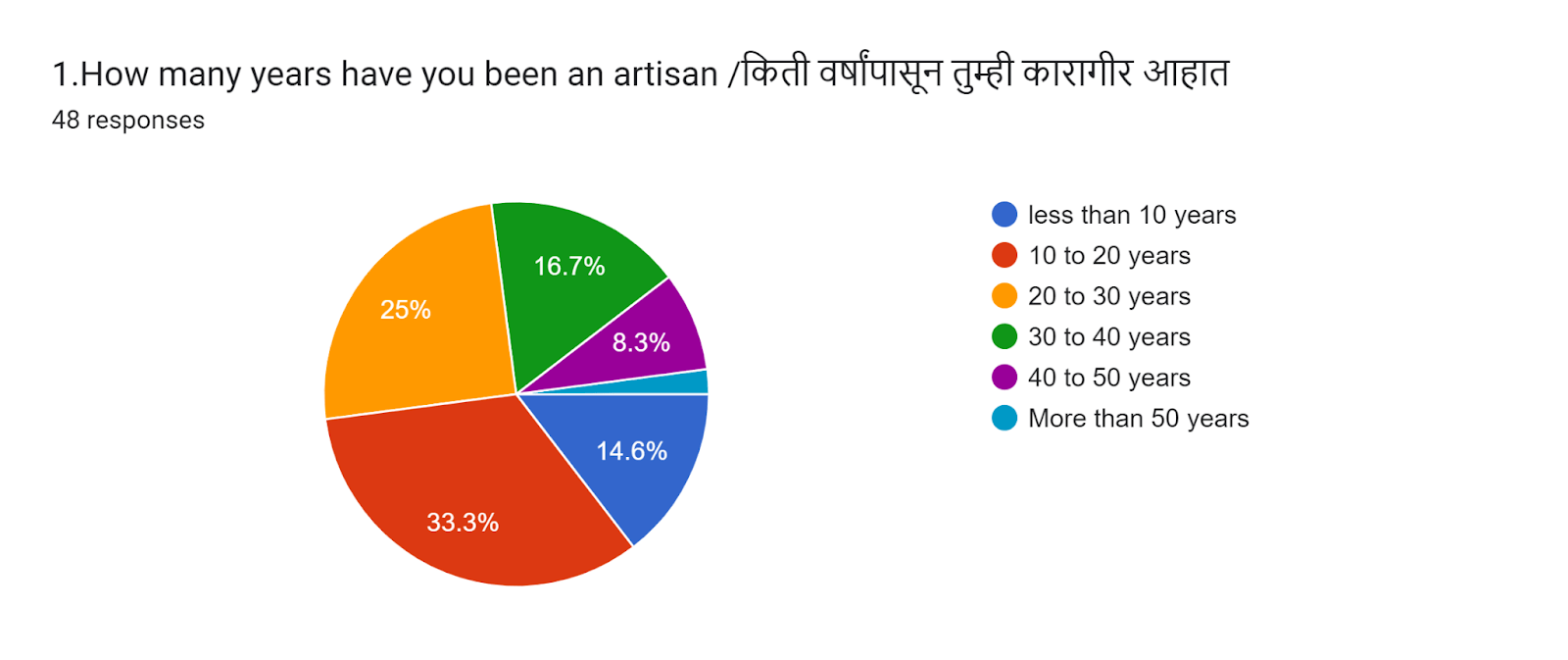
Assumptions: As access to technology improves in rural India, the preference for hand work or labour is reducing. Traditional handicrafts are fast diminishing yet there are a few communities that are attempting to keep these alive. This question was posed to them to establish the authenticity of their work and to know whether the sculptor was carrying forward a family tradition of idol making.
Findings: Only 15% artisans have recently started this craft, 58% artisans have been doing this for between 10 to 30 years, 25% are doing this between 30 to 50 years and only 2.1% are from the elder generation working on this for more than 50 years.
Notes: Mostly the artisans in Sindhudurg are traditional artisans.
Q2: Is this your main profession? (48 responses)
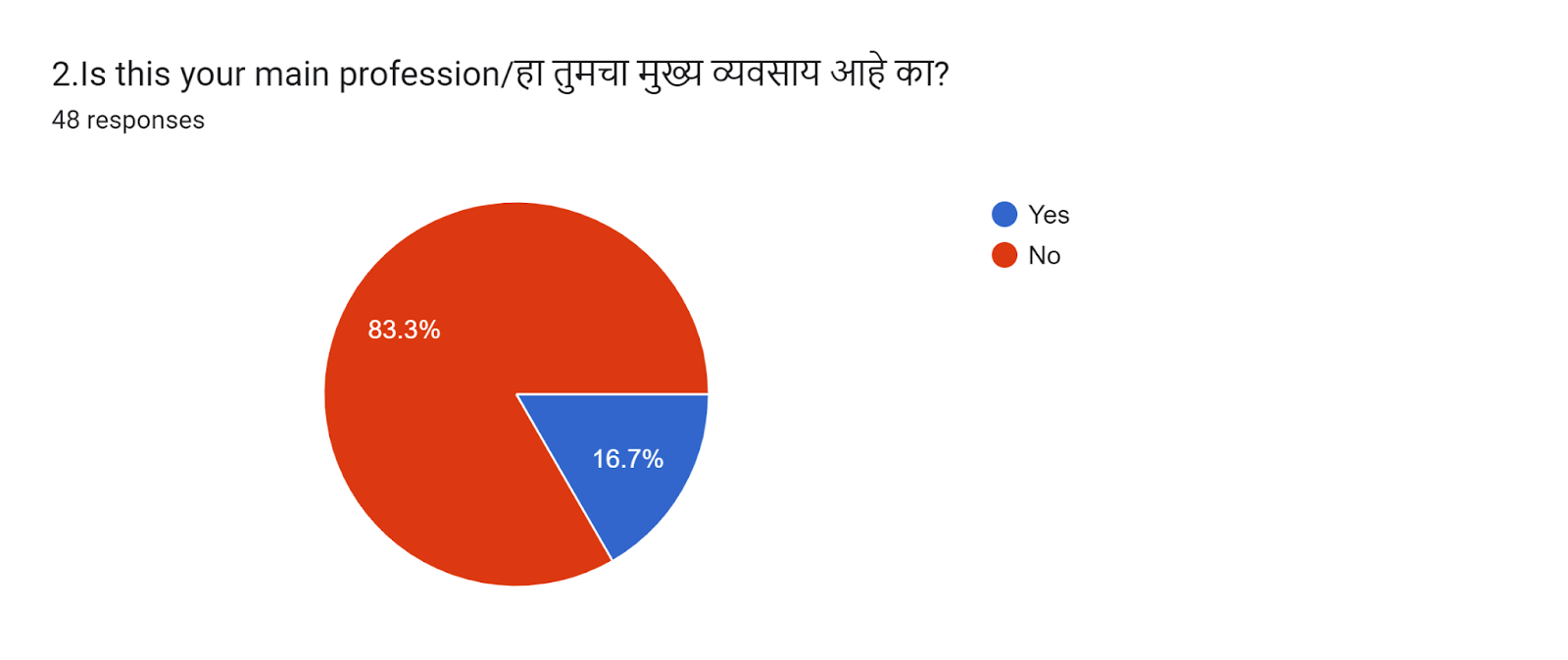
Assumptions: If this is the only source of income for artisans they are likely to be negatively impacted by any regulations on it. Since this is a seasonal activity the artisans may not be able to support their families for the entire year and do it only as a side business. Especially smaller producers cannot sustain on this for the entire year.
Findings: In this region, 16.7 % artisans make idols for the entire year as their main profession. However 83.3% only do this seasonally.
Notes: The artisans shared that they would like to keep the tradition of sculpting Ganeshas alive in their family and hence even if it is on a small scale they continue to sculpt. It may also be that since the market for these idols does not provide them a sufficient income all year round, they have turned to other activities.
3. If not, what other professions do you have ? (40 responses)
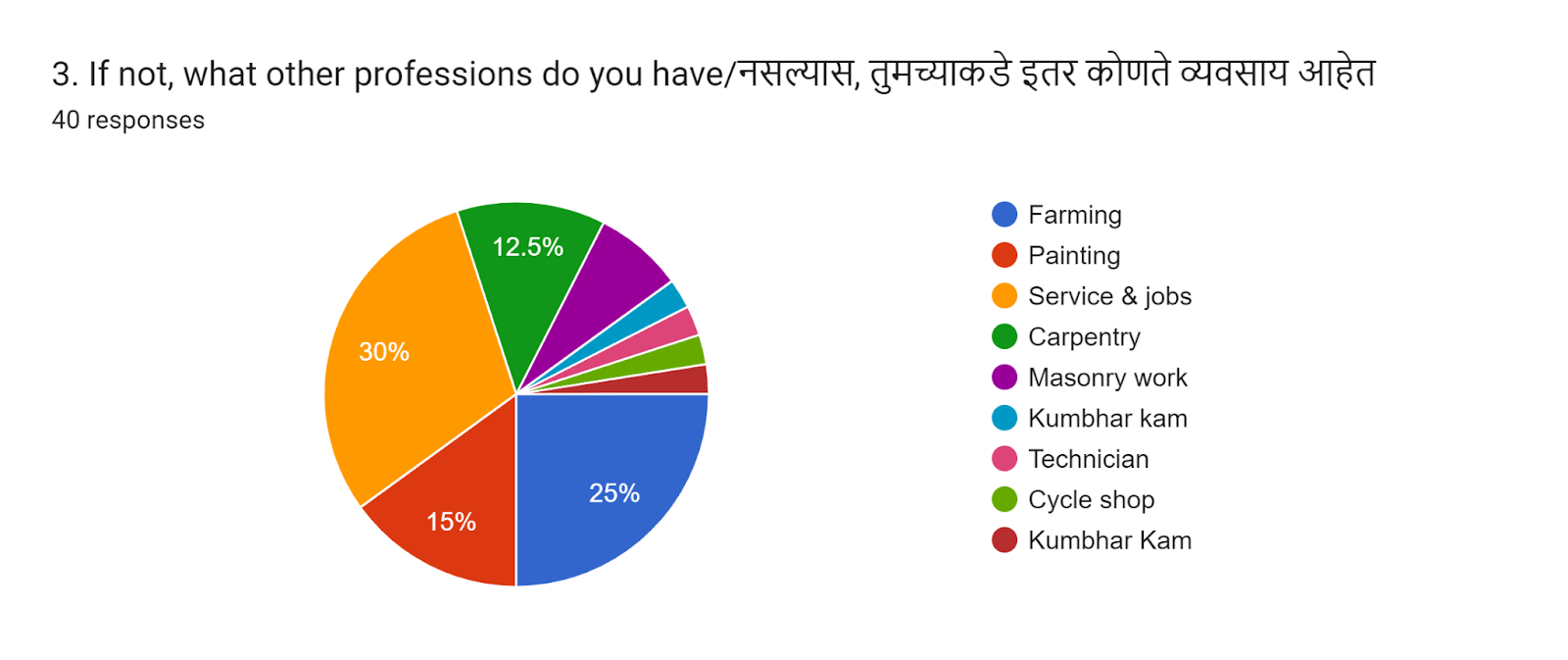
Assumptions: The shift of activity from craftsmanship to other types of hand labour is indicative of the changing markets in India. Patronage required to keep such crafts alive is not available and without support from they may not be able to sustain it.
Findings: Almost all the artisans have parallel handiwork occupations. 30% are employed elsewhere in service or jobs. 25% are farmers – this means they have easier access to farm soil.
Notes: Since artisans have migrated to larger cities for jobs , they return to their villages for the Ganesh festival to do this work. This relocation to urban areas limits the amount of production they can do. It would be interesting to explore whether they would prefer to come back to their villages to work on this if they can be assured a steady market. This could assist with development of rural livelihoods.
4.Is anyone else in your family in this profession ? (48 responses)
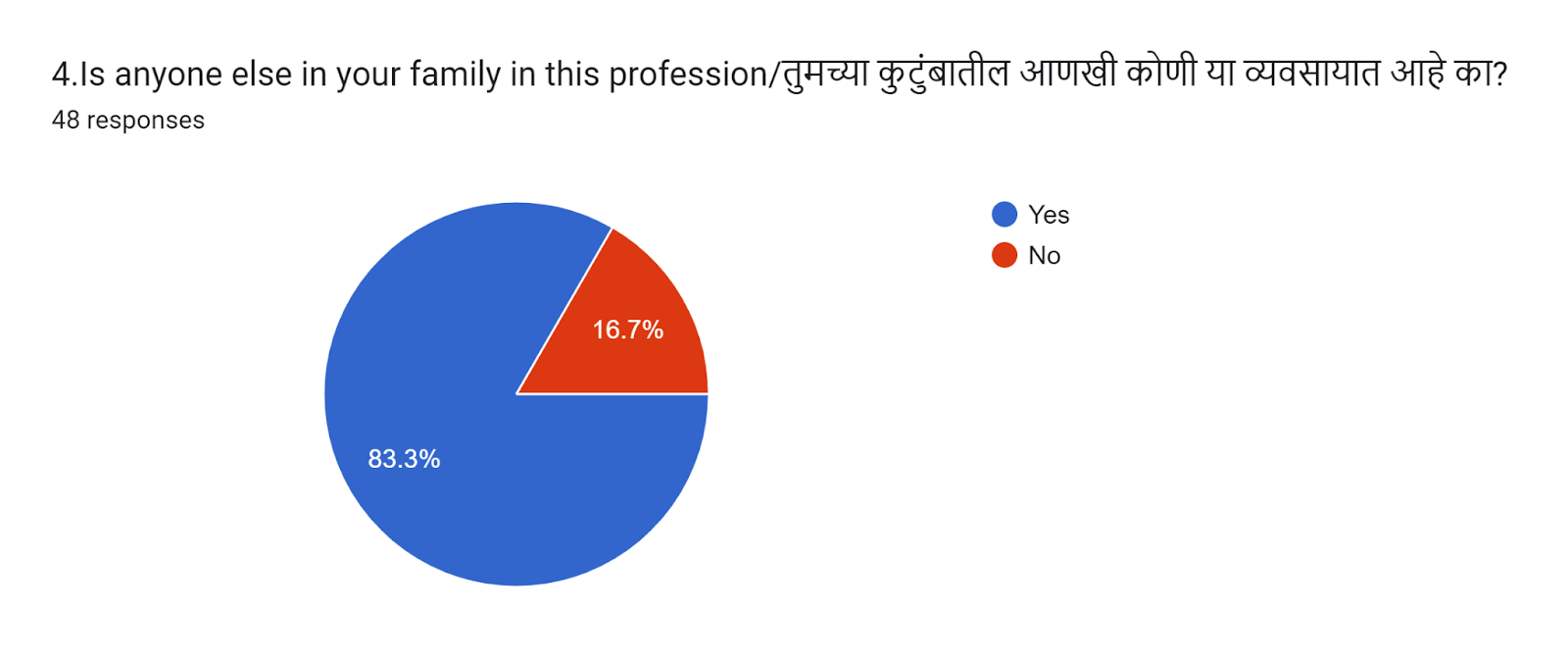
Assumptions: For smaller artisans it may be crucial to have labour support from the extended family as they may not be able to hire external labour for this. Larger artisans are able to hire labour on a daily wage.
Findings: Children are taught the skills of sculpting early, and all family members help in the production. This indicates a family collective activity which also includes the female members who often specialise in detailing. Specialization of tasks such as painting , or especially painting of the eyes which is a critical element is done by experts only. Those family members who do not participate are mostly those who do not know the skill. Labour that is employed is mostly female labour, giving the tasks to women self help groups etc.
Notes: Elders and youth both can participate in the sculpting of the idols and this can become a unifying factor in the family.
5. How much do you earn from this activity during Ganesh season ? (48 responses)
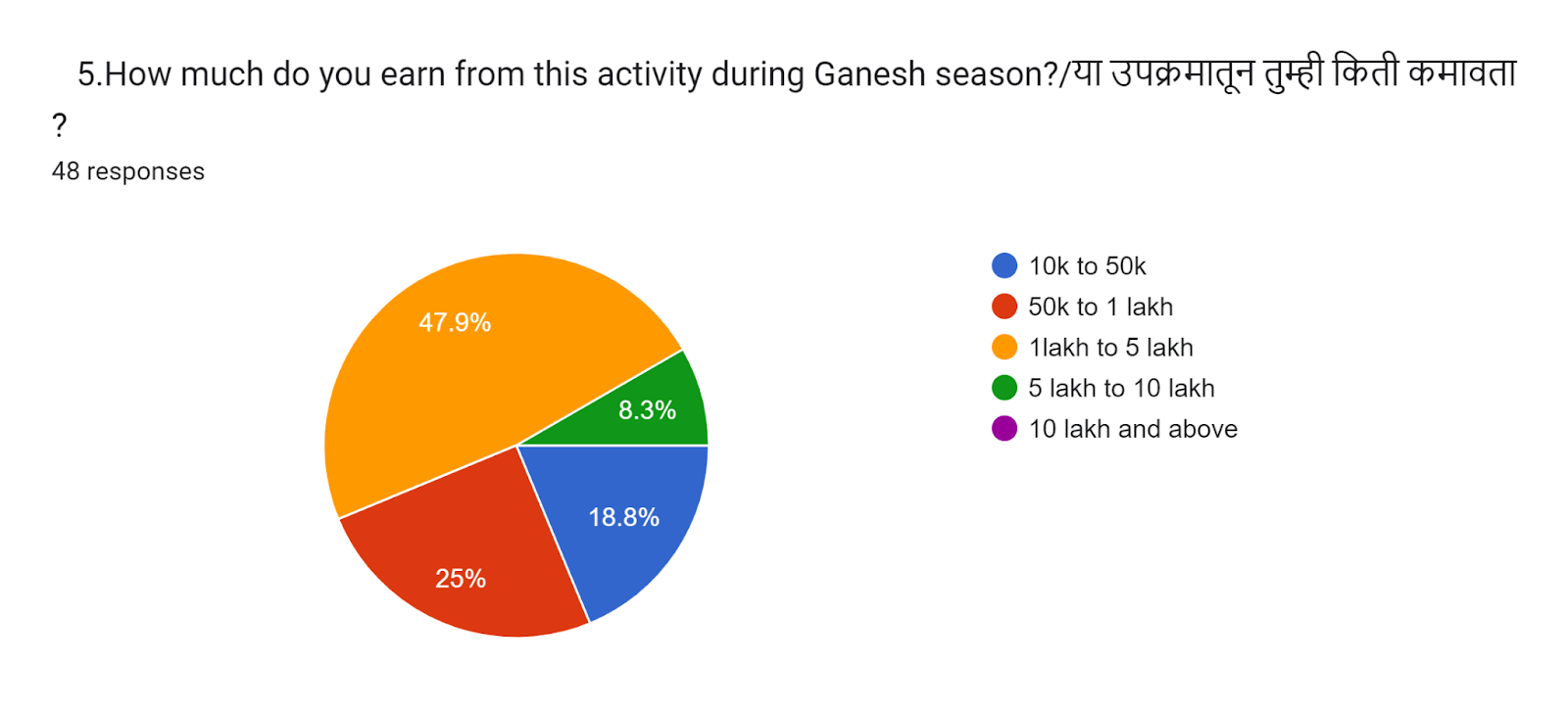
Assumptions: This question was posed to find out whether a craft like this could support a family.
Findings: Those artisans who do this work year round can earn enough for a year. Those who do it only seasonally still are able to earn upto 1 lakh or more within two months of this activity. Demand is growing for idols and the artisans are hopeful. Those whose main intention is to carry on the tradition work on a no profit no loss basis.
Notes: Those artisans that can make larger size idols are able to earn more – however not everyone can make bigger idols as the skills required are more to do with assembly of parts. Also there is a definite patronage in place in the villages which is assurance to smaller artisans – those who have more patrons can earn more.
6. What material are the majority of your models made from ? (48 responses)
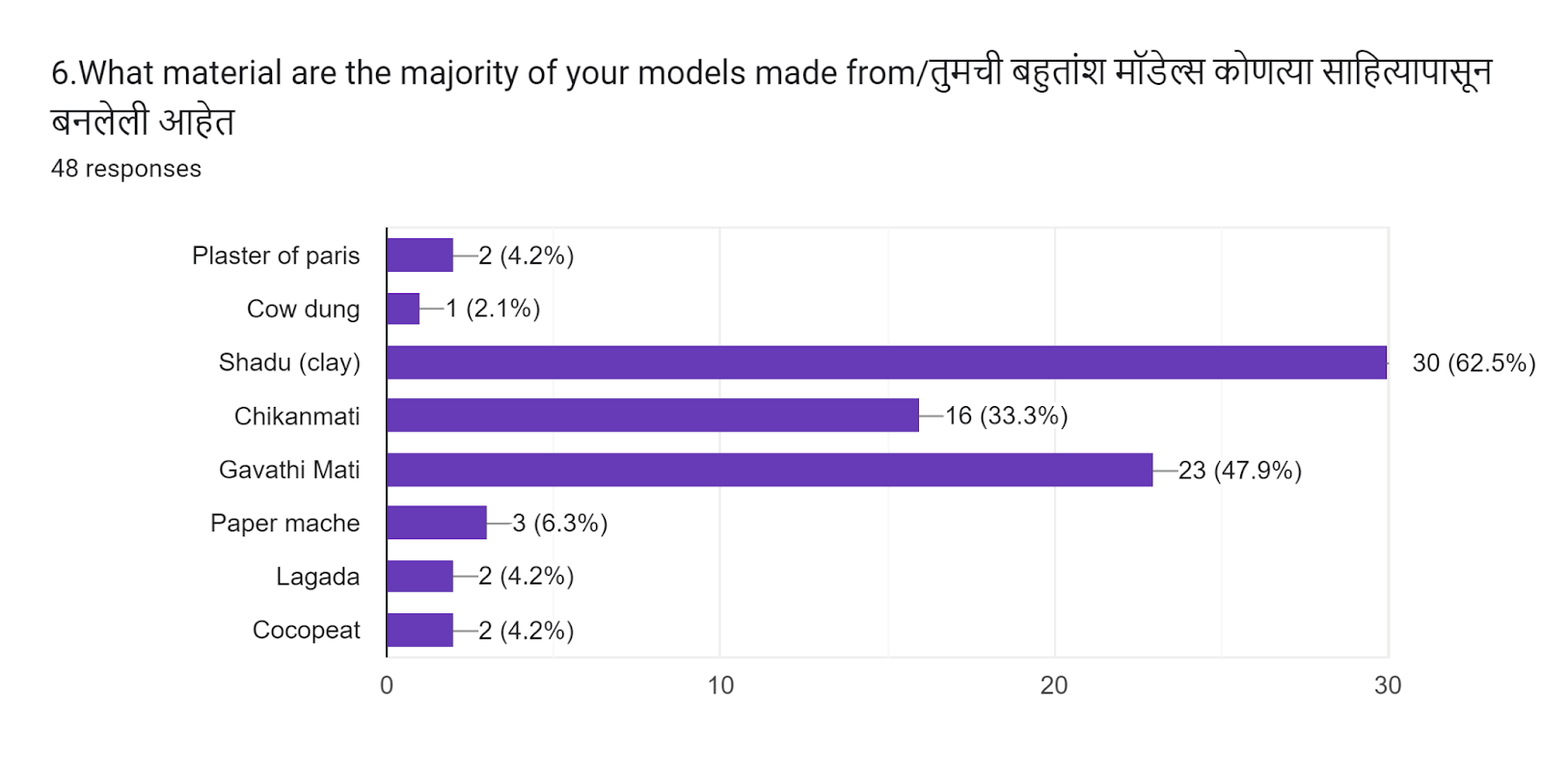
Assumptions: Production of idols in rural areas depends greatly on the availability of raw materials in that region. This question was also to explore the availability of plaster of paris and clayey soil in this area.Buying raw materials from the market is more expensive than taking it from your own farm or neighbouring lands or from the river banks.
|
Findings: There are three types of soil available for the artisans in Sindhudurg. Along with clayey soil available in the market, they also use local Chikhanmaati ( sticky soil) and Gavathi Maati – which is local village or farm soil. Some of this is mined locally. Notes: Farm soil is fertile top soil which is very critical for the health of the farm – when this top soil is harvested and sold by farmers for use in brick making or idol making, it leads to a loss in fertility of their lands. However, when a farmer is struggling to make ends meet it also provides them an alternate source of income. |
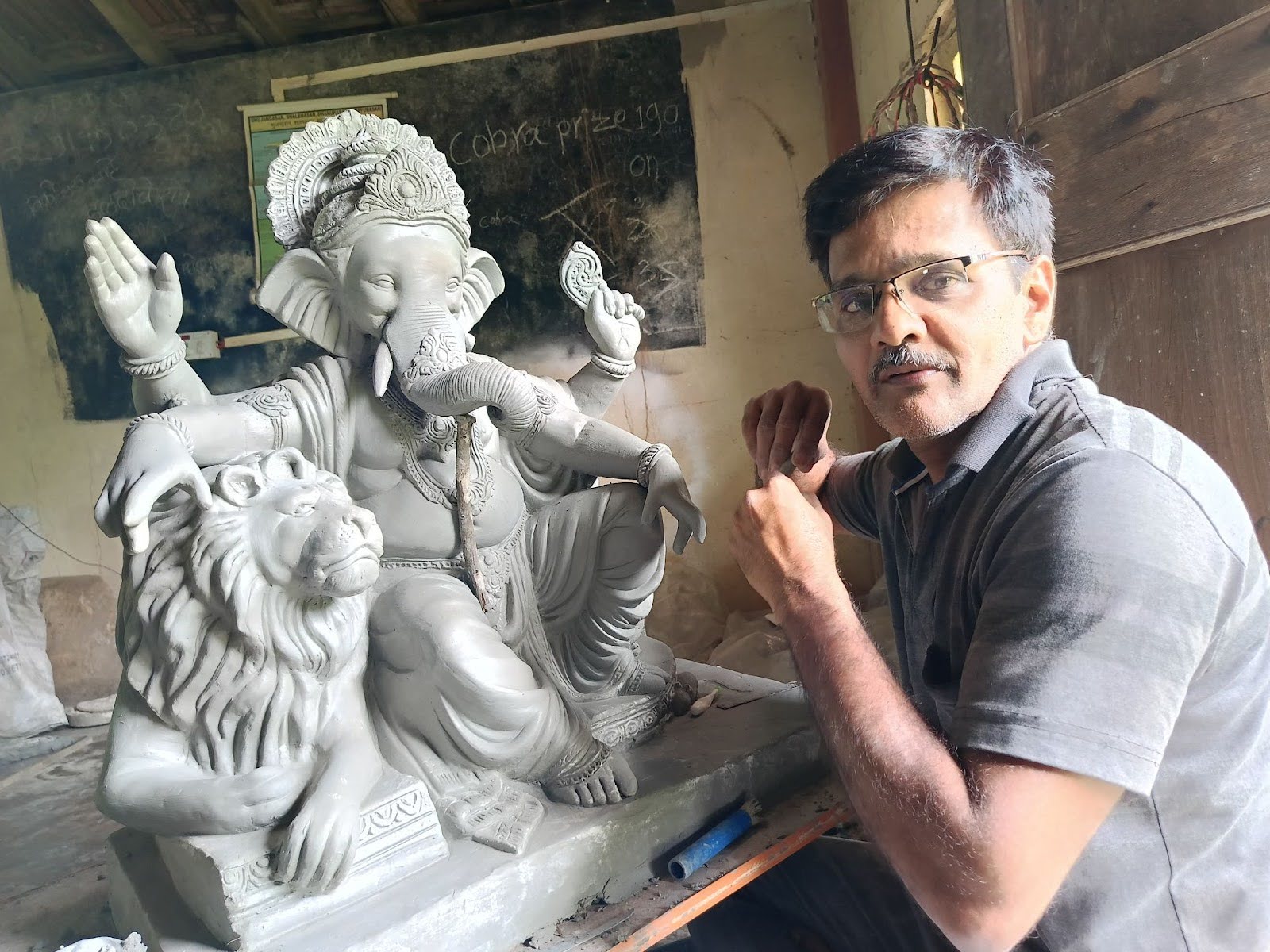
7. Why have you chosen this material ? (48 responses)
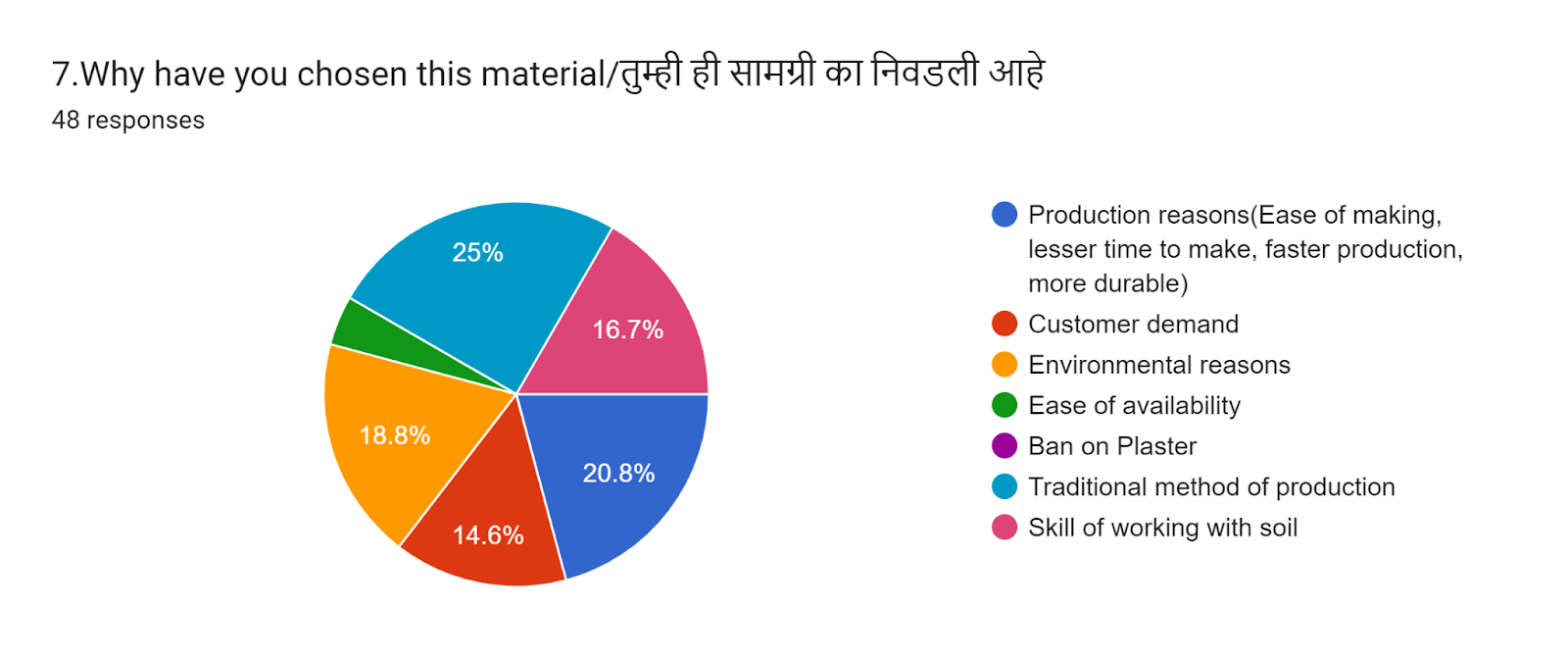
Assumptions: The choice of the material is important to know when we are trying to change the materials they use to promote more eco friendly options. What are the factors that affect this choice of material? Is it mainly availably? This was the reason behind this question.
Findings: Local availability of soil, traditional skills in soil art, and customer demand seemed to equally affect the choice. A good 19% were aware that some materials had a positive environmental impact and therefore chose it. As POP idols do not require a high level of skill, plaster of paris was chosen, only by 2 artisans out of 48. One of these is a recent startup, whereas the other only makes it for a specific customer on demand.
Notes: The comparison of cost of natural materials to industrial materials is challenging – artisans indicated that they purchased local soil for Rs 4000 per brass ( 100 sq ft ) as opposed to Rs 270 per sack of Shaadu Maati bought in the market which could be between 35 to 40 kg.
The customer demand is primarily for clay idols in this region and this influences the choice of the artisan. The awareness among consumers about environmental impact is possibly higher here.
8. Where do you get the raw material for the idols ? (48 responses)
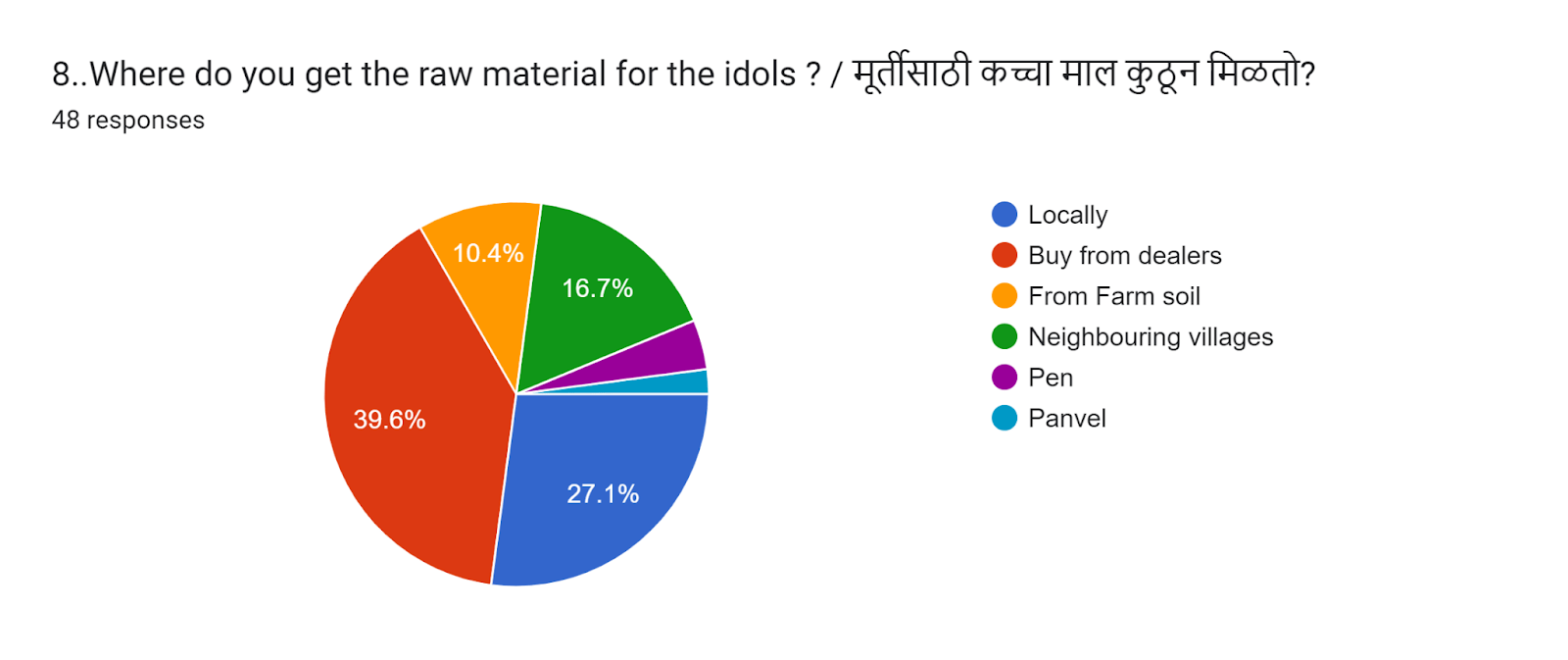
Assumptions: The ecological impact of the activity of sculpting Ganesh idols is aggravated when the raw material is travelling from a longer distance – often the material does not disintegrate or get absorbed fully into the soil when it is coming from a different ecosystem. The availability of local soil as well as its potential for sculpture is also critical. The cost of the production reduces when the raw material used is local.
Findings: About one third of artisans are sourcing the raw material locally yet nearly 40% are still buying it from the market. Only 10% are using their own farm soil.
Notes: The powder bought from the market may be clay from different sources or local soil that is put into the distribution network.
9. Do you think this material is good for the environment ? (48 responses)
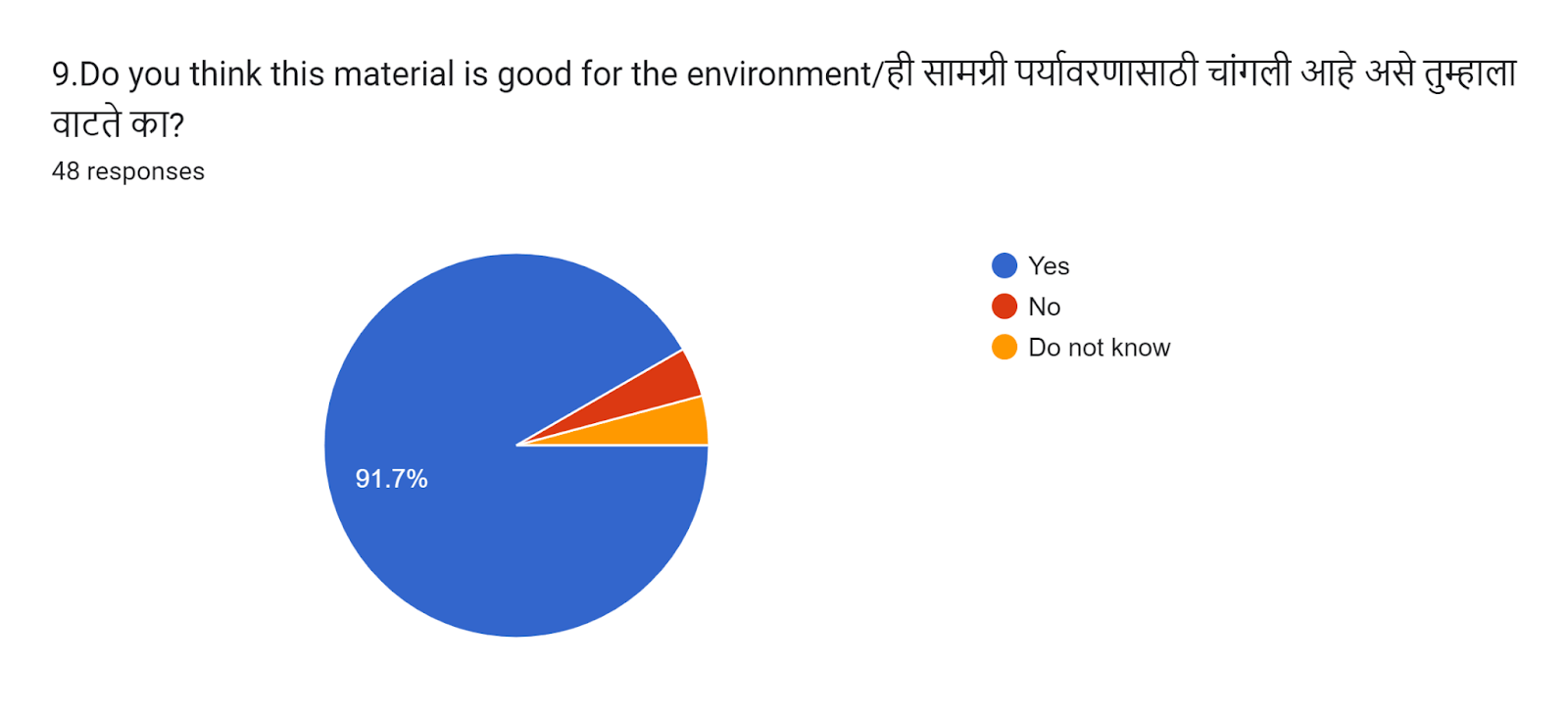
Assumptions: This question was posed to gauge the sense of responsibility of the artisans to the impact of the materials they use and their understanding of ecological impact of the material.
Findings: Over 90% replied in the affirmative when questioned about the ecological impact of the soil – some were aware that even soil has its negative impacts because it is a non renewable resource.
10. Why do you think so ? (47 responses)
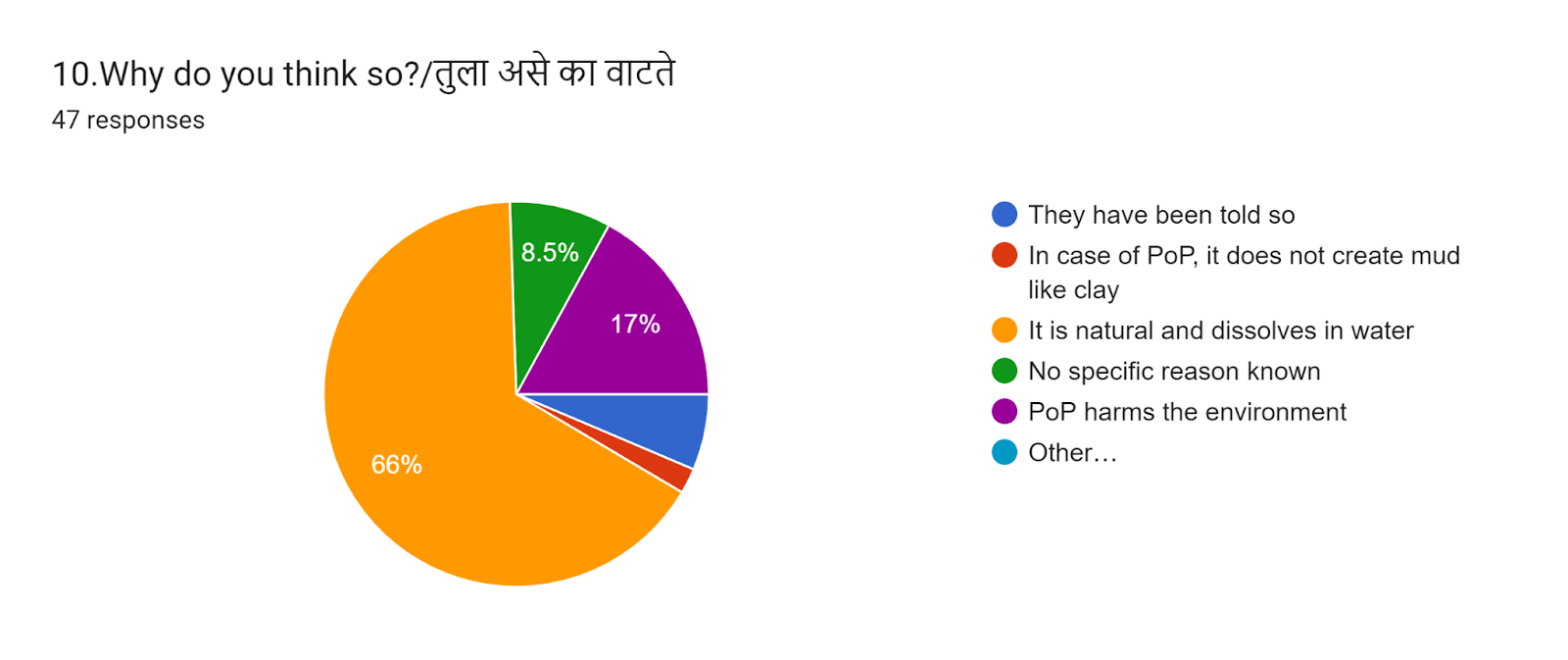
Assumptions: The opinion of the artisans may be influenced by the unions they belong to or by those who are aware of the ongoing litigations around Plaster of Paris. Also , it is important to understand the deeper assumptions about ecological impact that exist in this community.
Findings: Most of the artisans had considered this question before and seemed to have some understanding and opinion about it. The reason given for soil being better for the environment was that it dissolves in water. Some said POP was not good for the environment and others who are simply carrying on a tradition could not specify the reason they thought so. Some said that POP was in fact better because it does not create a sediment like clay does.
Notes: Every material has its pros and cons – and depending on the specific context where the artisans work – the appropriate solutions for that context may differ.
11.How do you make a Ganesha idol ? (48 responses)
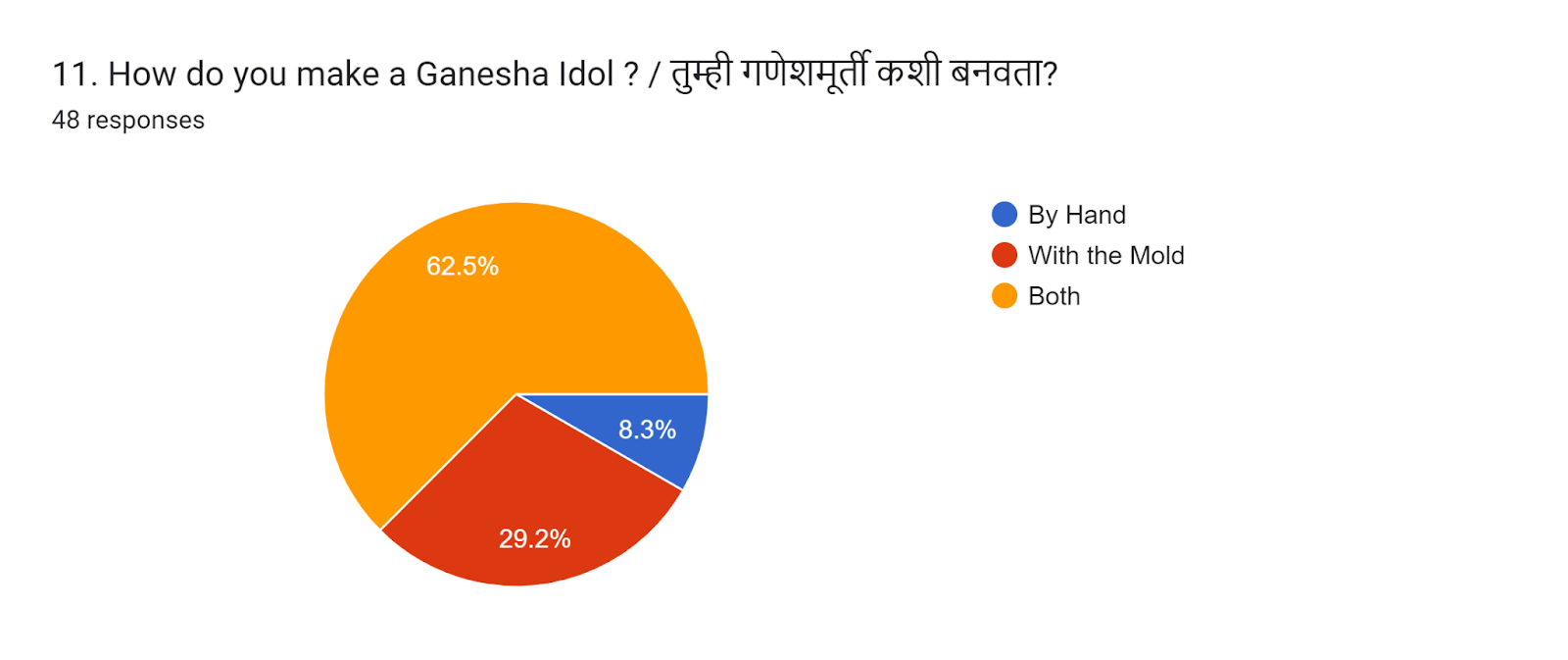
Assumptions: The labour going into making a Ganesh idol and the skills required for it are an important element in the production of the Ganeshas. As younger generations may choose not to continue the tradition this question was necessary to understand whether the master craftsmen are still active.
Findings: Only few of the sculptors are able to sculpt without a mould. These are usually the traditional artisans. Others take the help of moulds to duplicate idols and also to save time. Unique idols are made only on order by clients in the basis of aesthetics preferred by them ( for eg. to look like a saint etc )
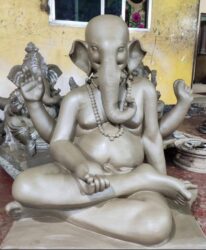
12. Are you aware of the ban on PoP ? (48 responses)
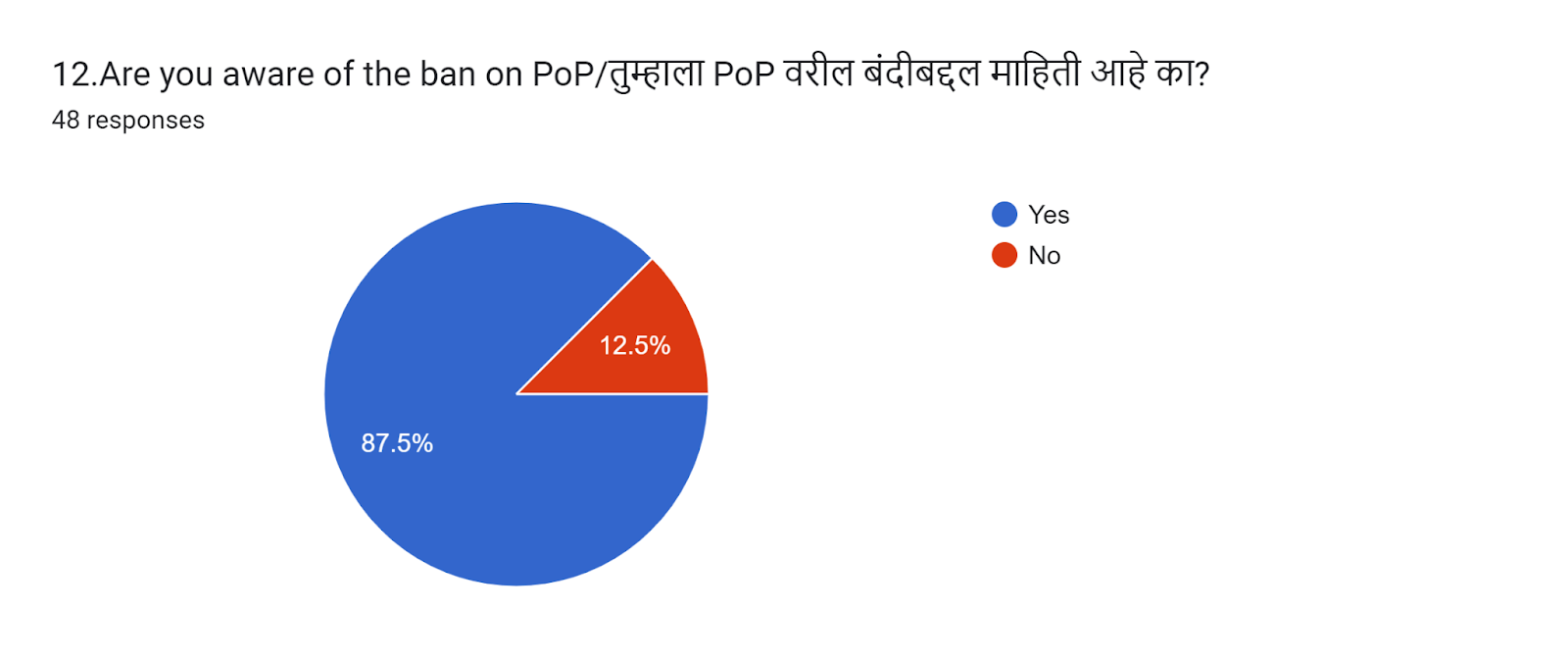
Assumptions: As the artisanal community is the major stakeholder in the implementation of the Revised Immersion Guidelines, it was expected that 4 years after the Revised guidelines were announced, the news would have reached all Ganesh artisans across the country.
Findings: Almost 90% were aware of the ban on Plaster of Paris.
Notes: The few that were not in agreement were aware that the guidelines were under legal debate and therefore not final. Those who were working with POP were aware that there was a ban but since there has been no enforcement they continued to work with it.
14a. If not , why ? (48 responses)
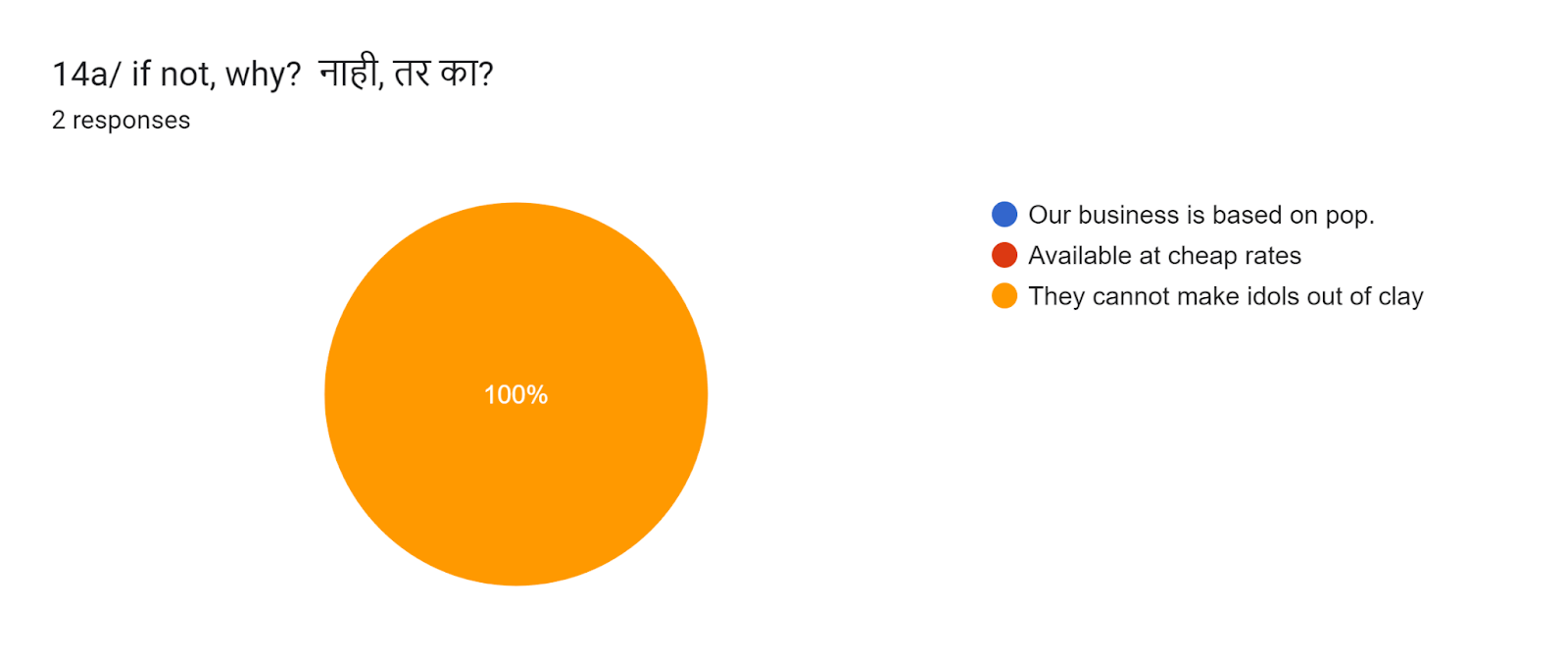
Findings : There are only 2 sculptors who oppose the ban. Because they are new to this profession and do not know the art of making idols from clay.
15. Has the ban affected you in any way ? (48 responses)
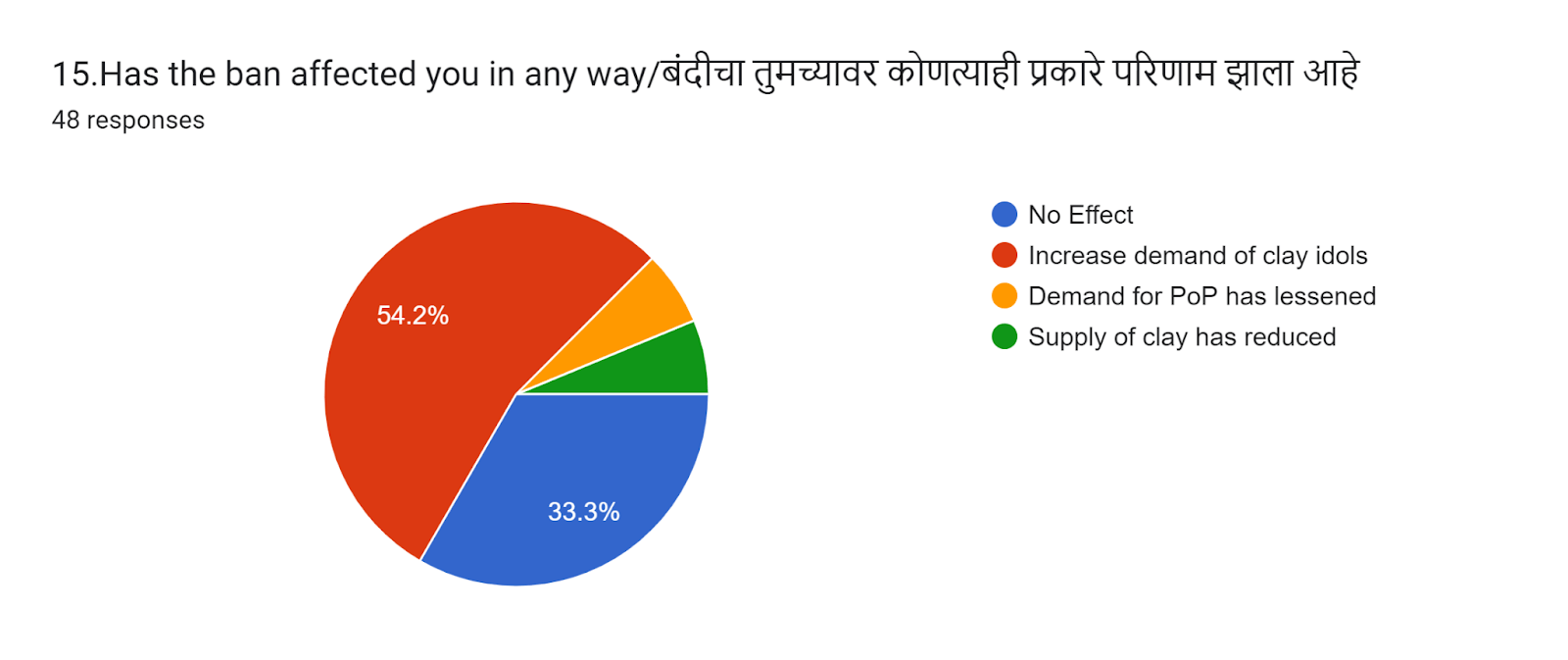
Assumptions: Resistance to the ban comes from being affected by the new laws – we needed to understand what kind of effect the ban has had on them.
Findings: Many of the clay artisans were actually pleased that the ban resulted in an increase in the demand for their work. Yet this also resulted in a short supply of the clayey soil ( shaadu ) as well as the local soil ( mines have been depleted ) and so this has created a new challenge. POP artisans mentione\d that the demand for POP idols has been affected.
Notes: With very little enforcement of the new guidelines, the artisans even in cities are unconcerned as they have not faced any direct penalties or checks from the government yet. However indirectly since the consumers are aware of the ban the market demand may have reduced for POP idols.
16. Do you know what the effects of PoP on the environment are ? (48 responses)
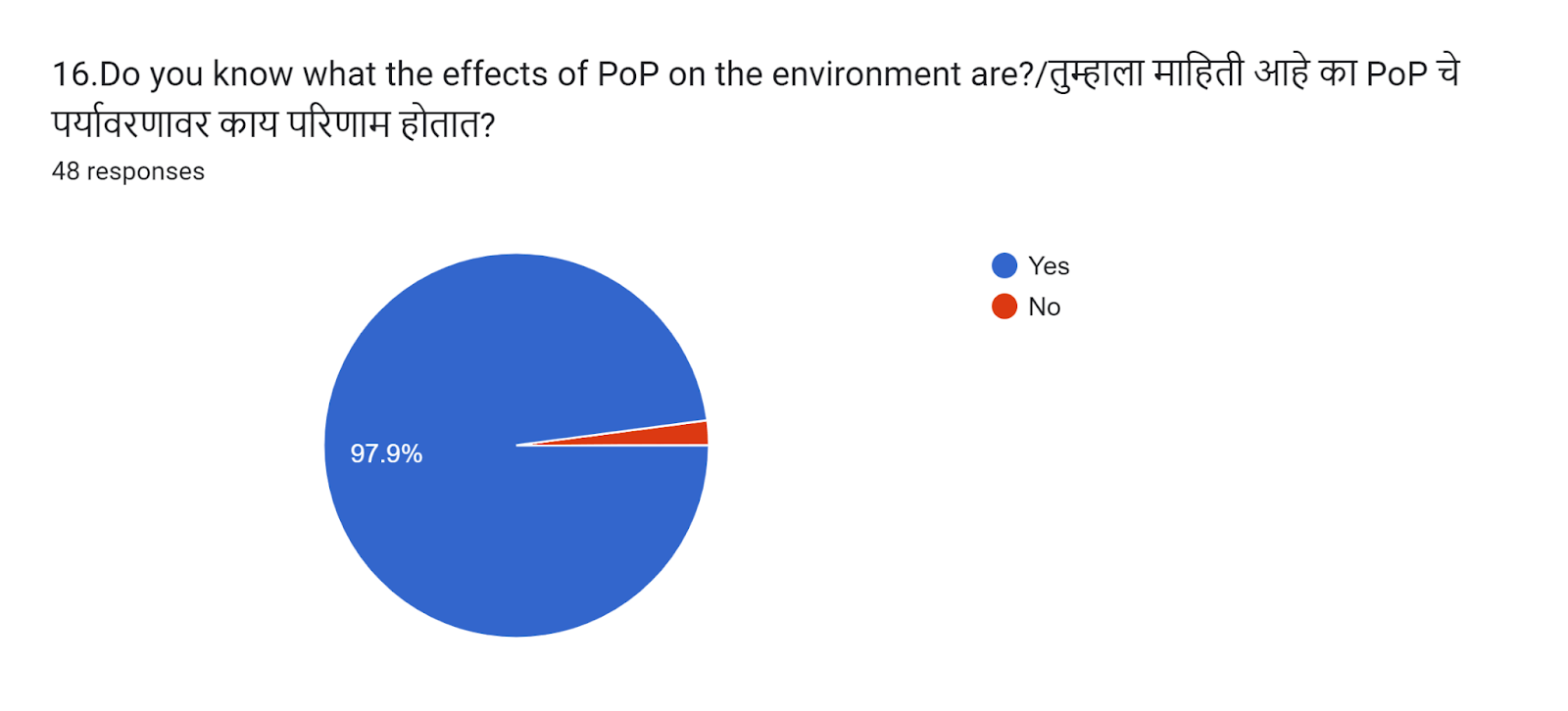
Assumptions: When working with a material so closely artisans are usually aware of the impact on their own bodies of any toxic materials that they may be using – for ge. POP releases heat when mixed with water, or chemical paints leave deep stains on the skin. With this familiarity of the material, we expected that the artisans would also have a though about the environmental impacts of POP.
Findings: Everybody knew except for one person.
17. Could you elaborate (46 responses)
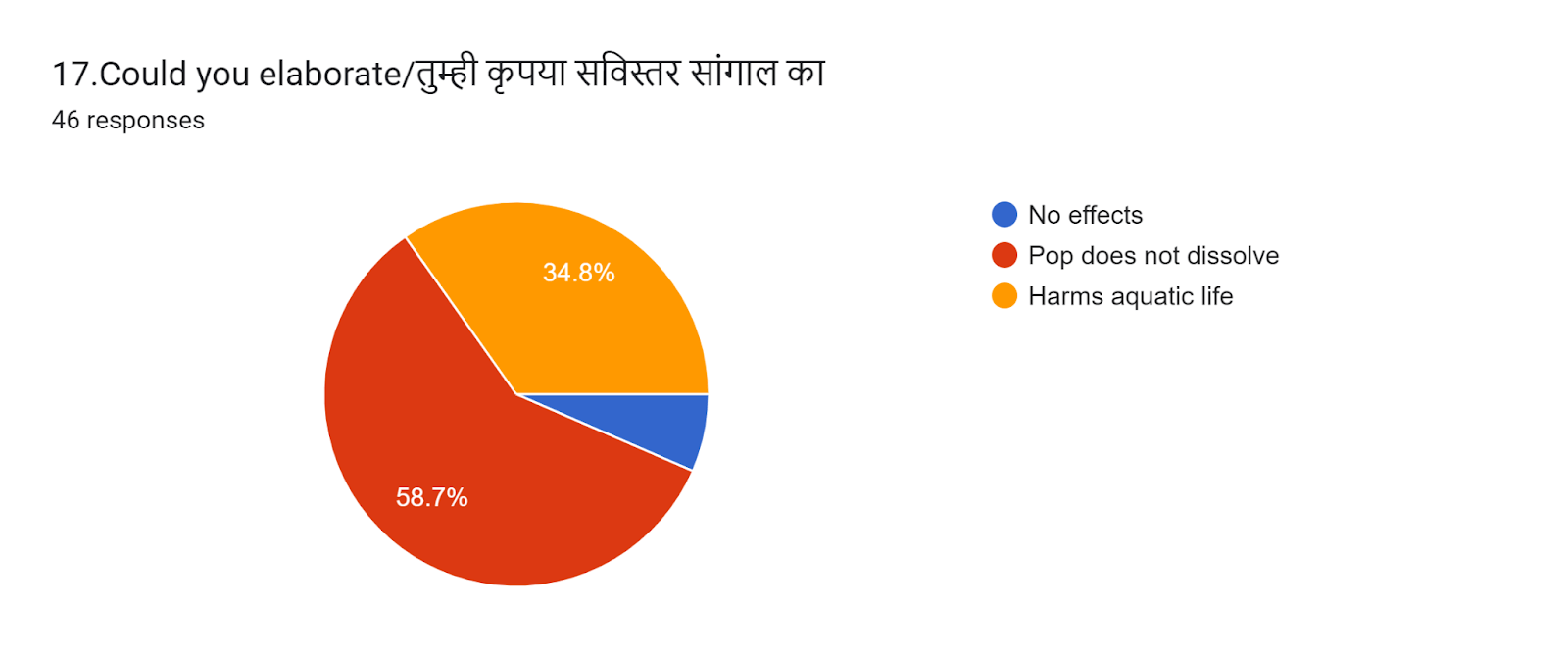
Assumptions: How exactly does Plaster of Paris harm the environment? This question is complicated because it depends on how you look at it.
Findings: Most answers were about the water insolubility of POP – this was presented as being a negative impact when immersed into natural water bodies. Some artisans said that POP releases a gas into the water when it has been sitting there for a long time.
18. What kind of paints do you use ? (48 responses)
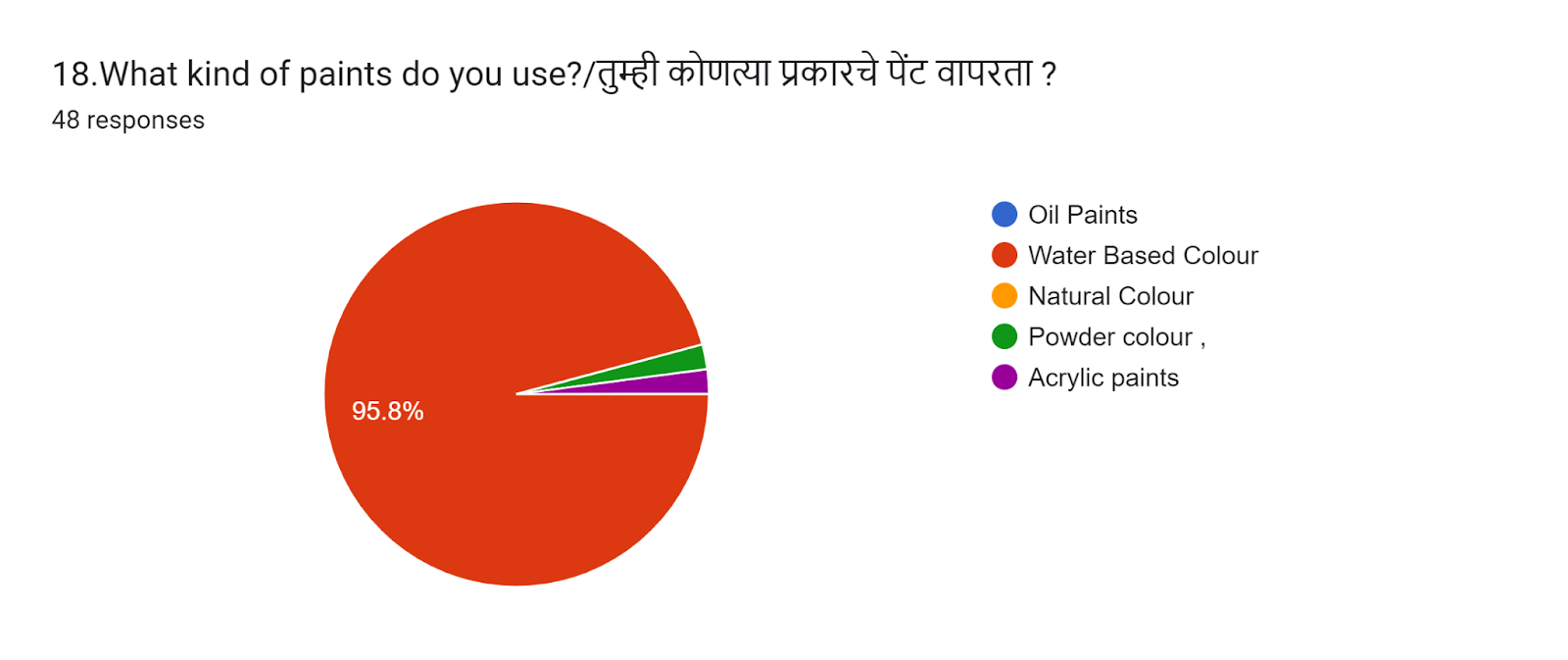
Assumptions: The topic of chemical paints gets forgotten often in the discussion on eco friendly idols as most artisans are still using chemical paints.
Findings: Nearly 96% are using water based paints which they buy from the market. The others cited acrylic paint and powders – none are using natural pigments and oil paints. Most choose the paints that are easily available in the markets. No one has tried to make their own paints.
Notes: The final look and appeal of the idols depends on the manner in which it is finished. Many consumers still prefer to have bright and shiny colours on their idols and some even ask for plastic glitter etc on the finished idol. The focus of the idol however is in the eyes – since the sense of presence comes from these. Unpainted idols are not yet considered here.
19. Do you think these paints will harm the environment ? (48 responses)
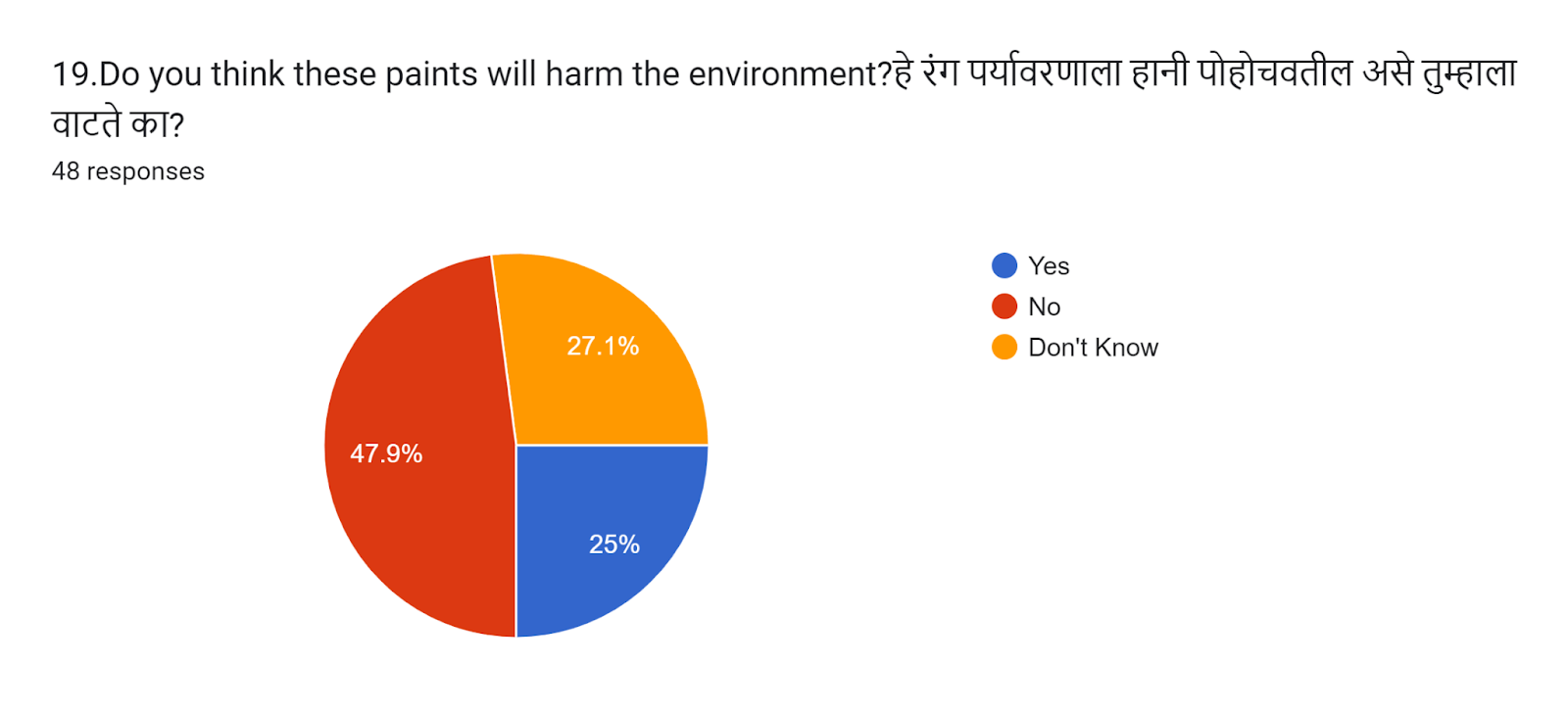
Assumptions: Does an artisan consider the impact of a paint before using it on his idol? This was the reason behind posing this question.
Findings: Half of the artisans believed that even the chemical paints they used were OK for the natural environment but one quarter were aware that since they contained chemicals they were not safe. The remainder did not know.
20. If no, why? (48 responses)
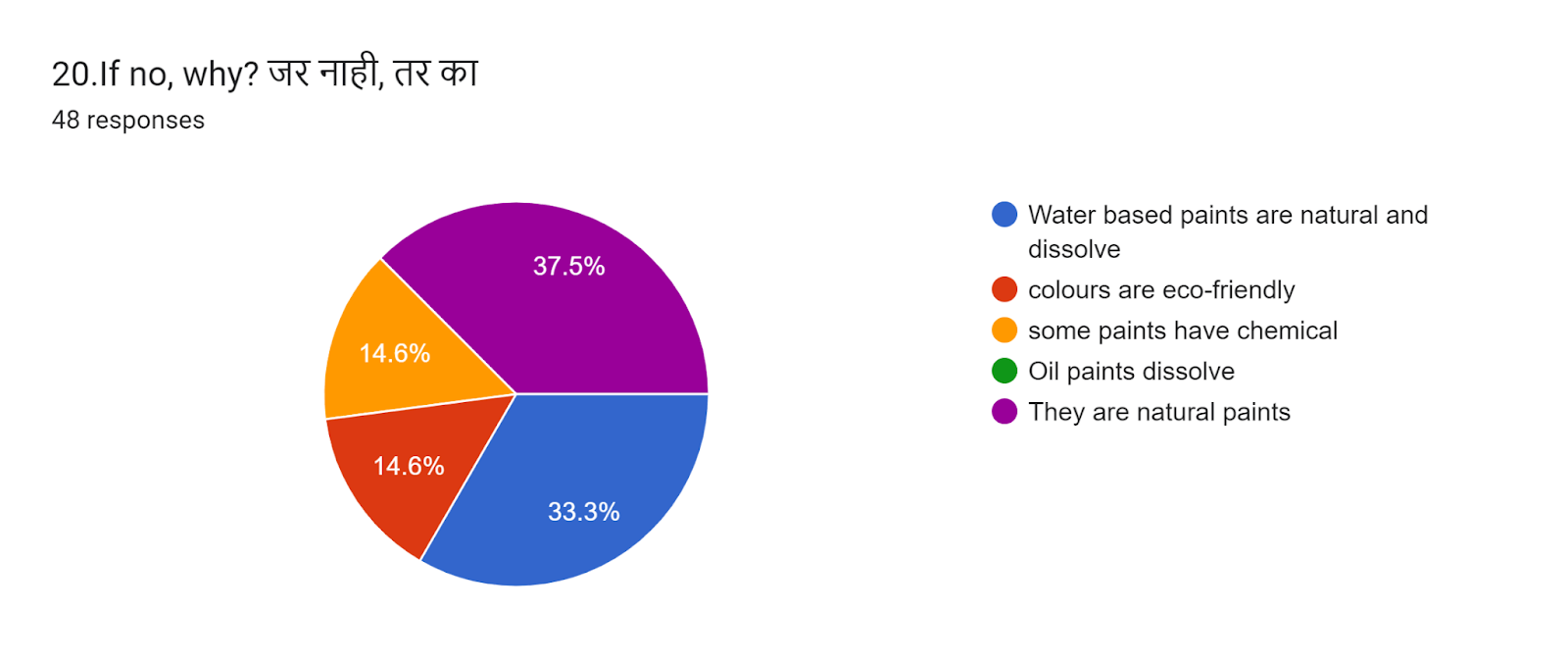
Assumptions: The idea that a paint is eco friendly if it dissolves in water is a common misconception among artisans. This question was posed to go deeper into their understanding of what is safe for the environment.
Findings: The difference between natural and chemical paints is unclear in the responses – some artisans believed that water soluble paints were in fact natural paints. Some felt that since they dissolve in water they would be relatively safer. The term ‘eco friendly’ is also a new label – which is not fully understood – even though 14.6% used this term in their response.
Notes: Often artisans depend on the paint companies who claim that their paints are eco friendly or on the opinion given to them by the unions.
21.Where do you have Ganesha Idol immersion ? (48 responses)

Assumptions: In rural areas the immersion of idols is scattered across the landscape as population density may be lower. This question was asked to understand the awareness levels regarding the immersion guidelines as well as to map out where the immersions are actually happening.
Findings: The bulk of the immersion are happening in river, while some in smaller streams and lakes or well. There are no immersion tanks built by the government and home immersions are not preferred. Proximity of the immersion site may also be a factor in choosing it.
Note: There is a belief that the immersion should be done in flowing waters and hence the choice of natural water bodies. Since the immersion may be happening across the landscape – the focussed impact on any one water body may be lower and not visibly evident.
22. Do you know what happens to the murtis after Visarjan ? (48 responses)
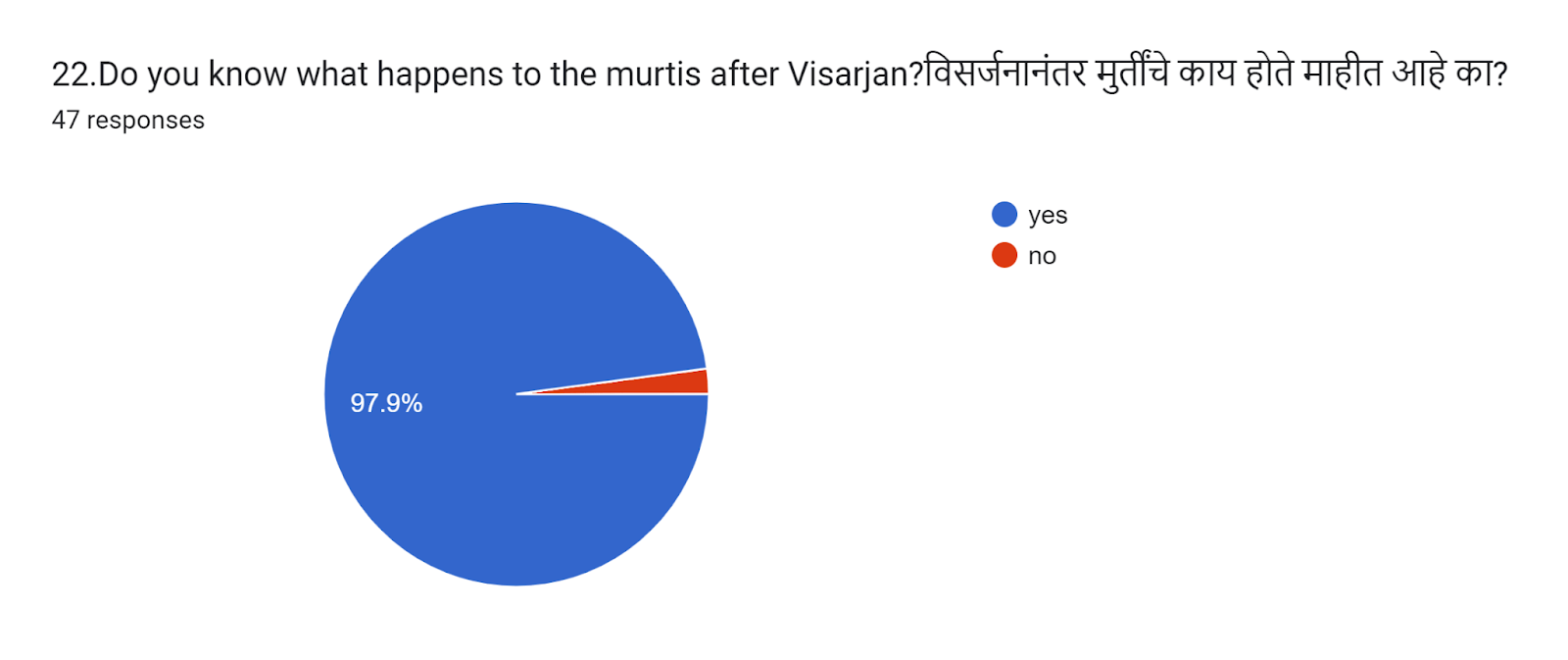
Assumptions: Responsibility for the final disposal of the products they create has not been put on the artisans yet. This question was asked to see if they feel a sense of concern as to the impact of their idols on their own rural landscapes.
Findings: The majority of the artisans knew what happens to the idols after immersion.
Notes: This question is about the impact of the material of the idols .
23.Could you elaborate? (48 responses)
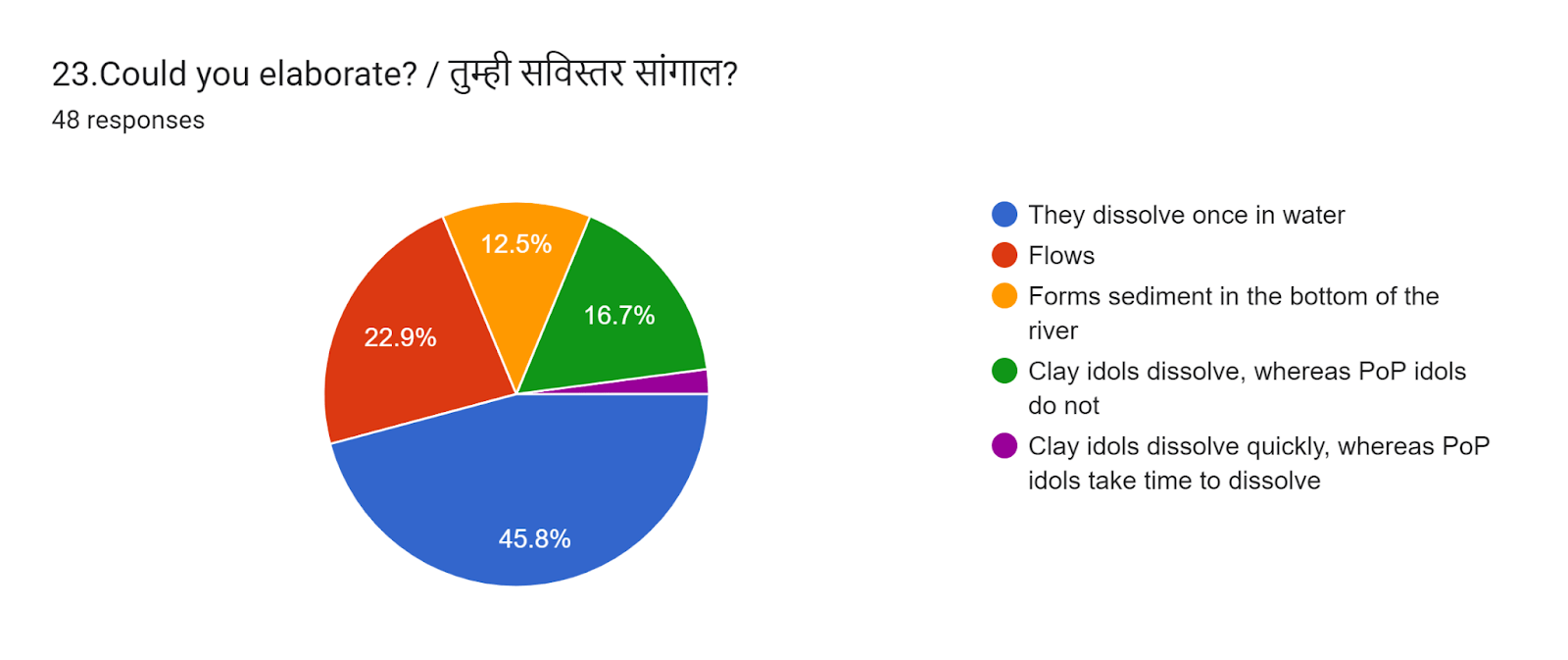
Assumptions: Often the worshippers of Ganesha do not visit the site of the immersion in the days following the immersion and therefore may not be aware of the impact of their rituals. Artisans who live in the same villages or town, should have an awareness of the ultimate destination of the idols after the ritual is over.
Findings: Clay idols dissolve in water – many of them flow away in the flowing waters of river. These were the answers of around 70%of the artisans – some were aware that POP idols do not dissolve.
Notes: Once again, the conversation is only around the solubility of clay or the insolubility of POP – the chemical or mechanical results of immersion were only mentioned by 6 of the artisans who spoke of the sedimentation of the clay after immersion. One of them still believed that POP does dissolve , only it takes longer than clay .
24. Do you export Ganesha idols to other locations ? (48 responses)
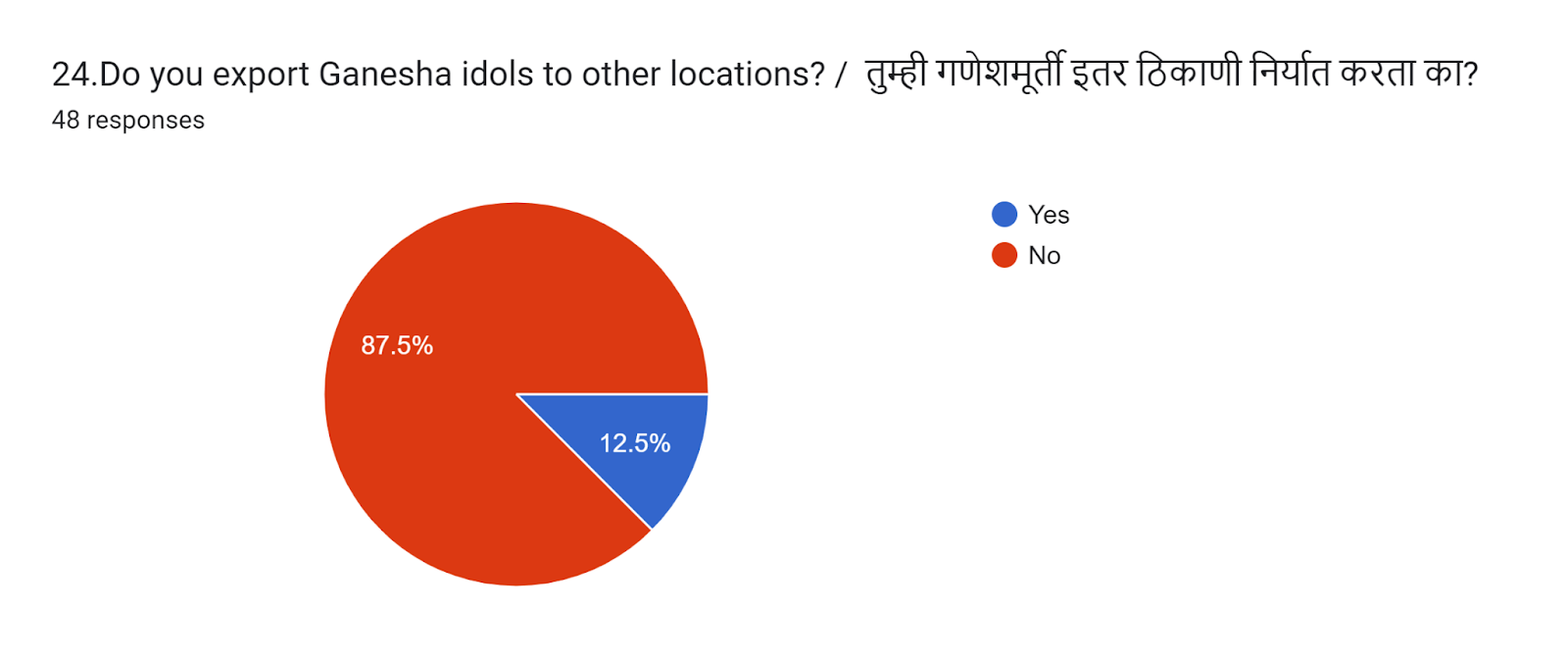
Assumptions: Availability of a market for clay idols is most important when trying to shift the materials used from POP to clay. If a market is not locally available then chances are that the art will suffer in the long run. Exports of idols to other towns where there are no artisans may help keep the tradition alive, albeit at the cost of a larger ecological footprint due to transportation over long distances.
Findings: Only a few artisans are able to export the idols – most of them are only serving a local market.
Notes: The scale of production might be a factor in exports as smaller artisans may find it challenging to risk the idols in transportation. However there was a willingness to explore this if they received marketing assistance.
25.Are you part of a union / Sanghatan ? (48 responses)
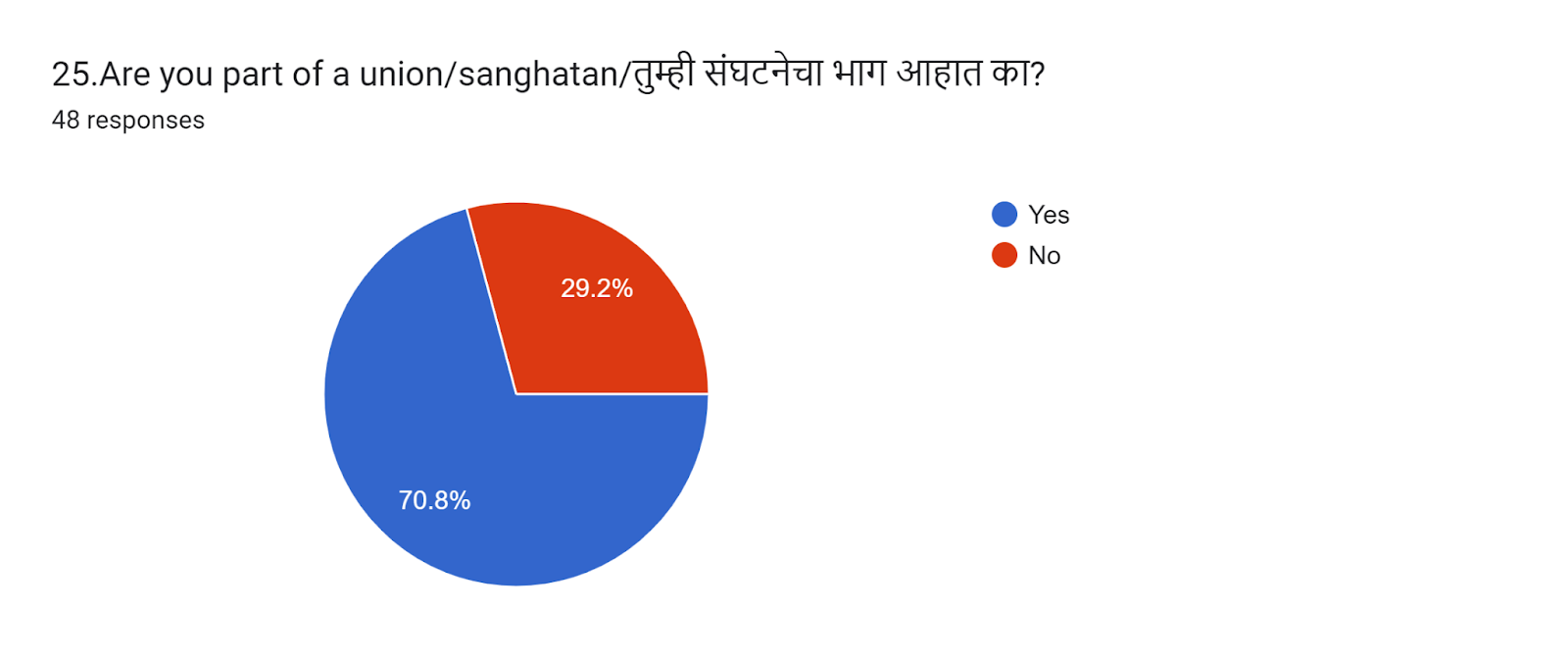
Assumptions: Representation of the artisans through a union that understands their needs and challenges may be especially important in rural areas where smaller artisans may not have the wherewithal to fight for their dues.
Findings: Nearly 71% artisans had registered with a union and depended on them for assistance.
26.Has the union / sanghatan reacted to the ban in any way ? (44 responses)
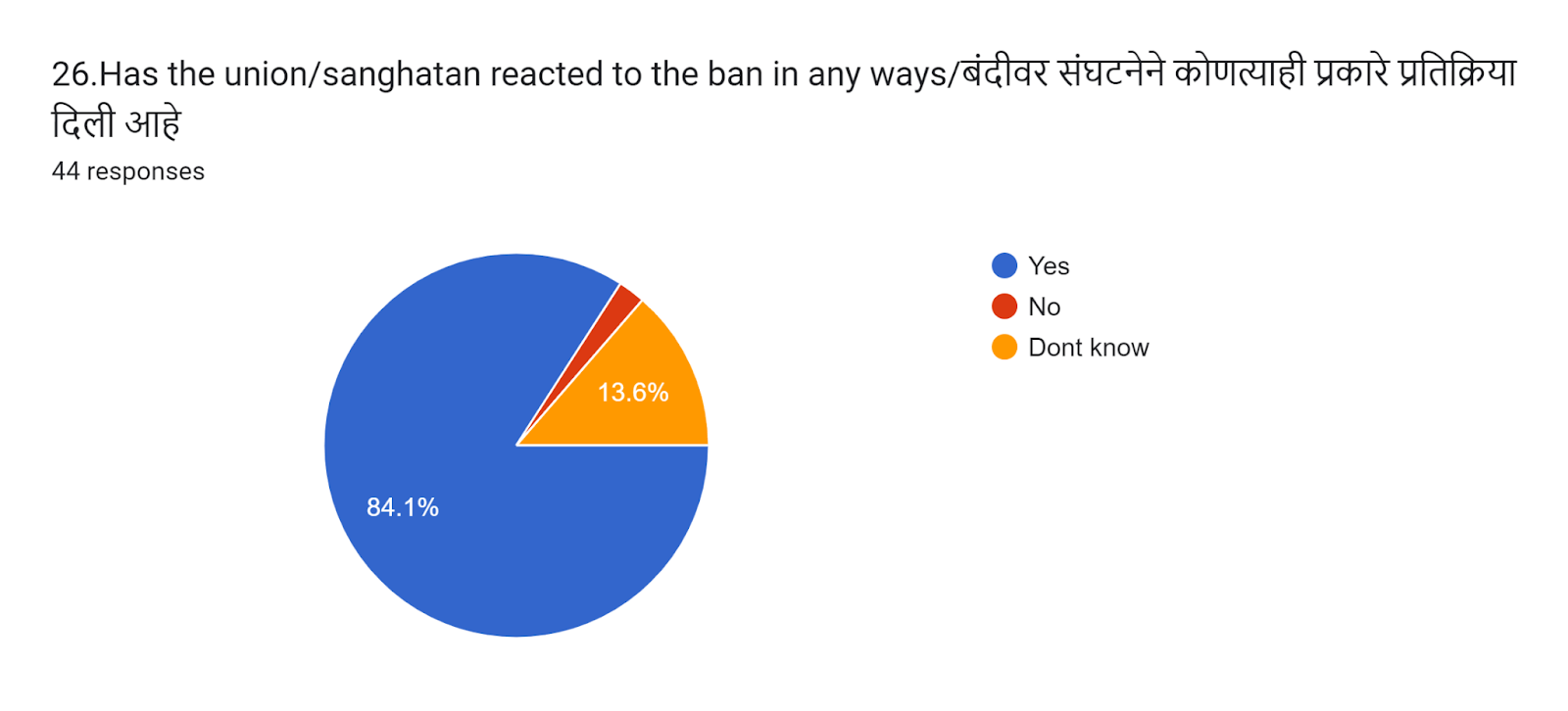
Assumptions: Unions or Murtikar Sanghatanas are expected to represent all artisans irrespective of the materials they use. The main mandate of these unions is the welfare of the artisans and not directly the conservation of the natural environment.
Findings: 84% of the artisans were aware that their Murtikar Sanghatana had indeed responded to the change in laws.
27. What steps have they taken ? (43 responses)
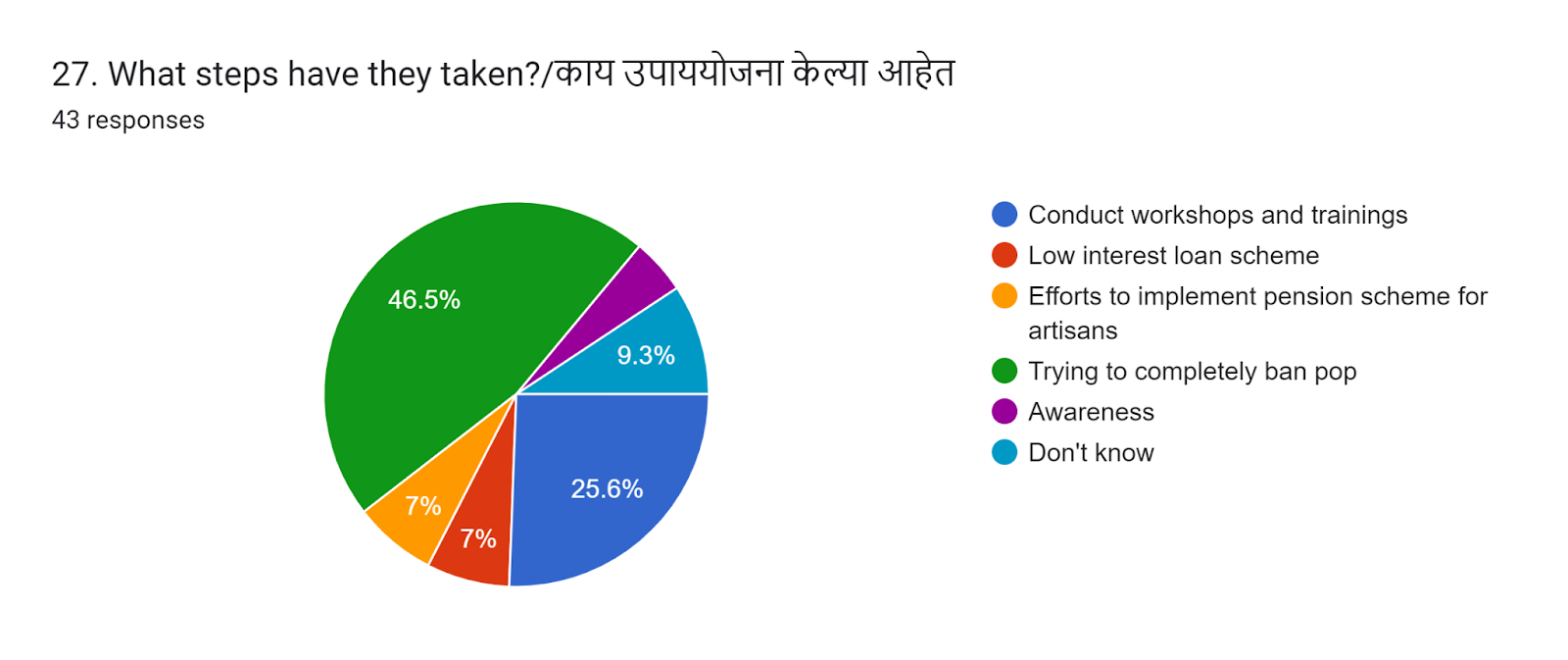
Assumptions: The unions wield power and have filed PILs against the ban on POP in many parts of the country. How much responsibility do the unions take for the ecological impact of the materials used by the artisans ? What steps are they taking to help the artisans through this change?
Findings: Interestingly the sanghatanas in Sindhudurg are primarily trying to get POP banned completely, which is different from the response of sanghatanas in urban areas such as Pune and Pen. They conduct workshops to help with skill development of newer materials such as paper mache and cow dung. They also try to offer financial assistance to artisans such as soft loans or pension schemes.
Notes: Preparing the younger generations to carry forward the tradition, the sanghatanas also organise competitions and exhibitions in Ganesha making.
28.What kind of help do you need from the government ? (48 responses)
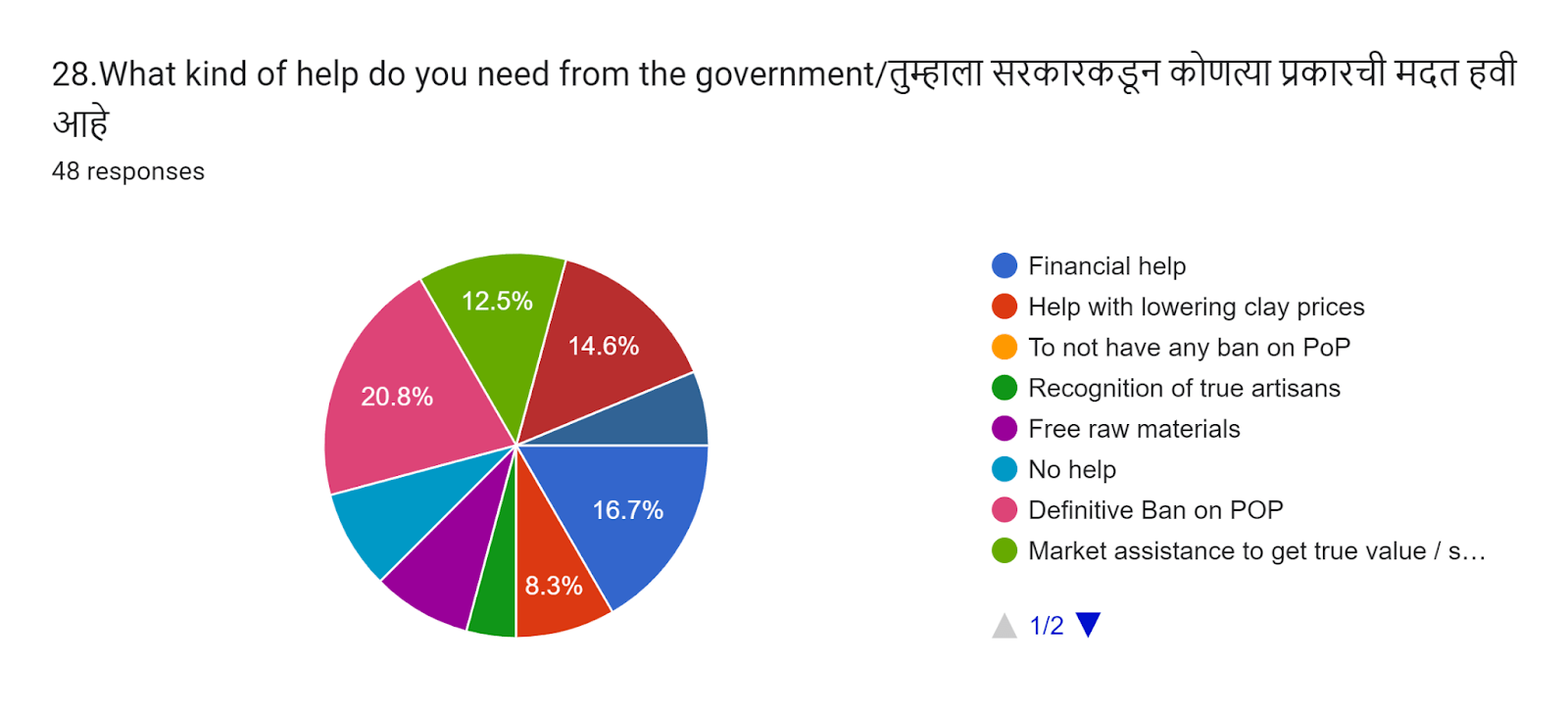
Assumptions: Has the government offered assistance to the artisans as they struggle to make a shift in their processes to become more environmentally friendly? What kind of help would enable the artisans to embrace this shift more easily?
Findings: Clay artisans want a clear and definite ban on Plaster of Paris. Recognition of this art form and registration or certification by the government would also be very helpful. None of the artisans interviewed asked for the ban on POP to be dropped. They also requested assistance with raw materials and financial support as well as support in getting fair prices in the market. In Goa, the government offers a payment to each artisan per eco friendly idol produced – this is in addition to what they get from sales in the market . Artisans in Sindhudurg requested such a scheme here as well.
Notes: The current system has categories of PAINTERS and SCULPTORS however ignores IDOL MAKERS – often because these are seasonal artforms only during the festivals. This lacuna results in a neglect of the idol makers.
29. Has the government ever visited you to check on the murtis ? (48 responses)
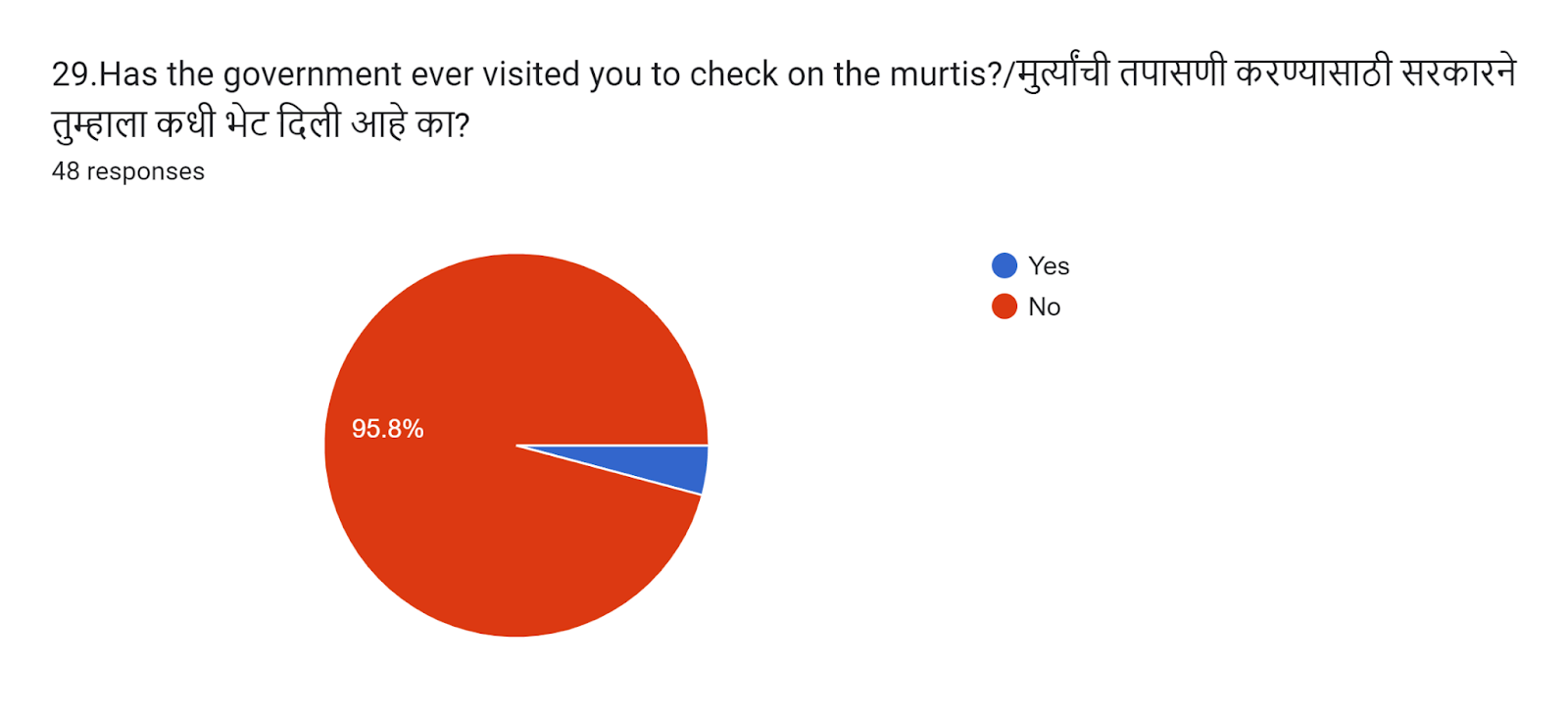
Assumptions: To enforce the revised guidelines the government has to create a system of enforcement at the ground level.
Findings: Only two of the artisans were visited by government officials from the Taluka office – only once.
Notes: There seems to be a huge disconnect between the government and the artisanal community.
30. Do you expect the next generations to continue with this work ? (48 responses)
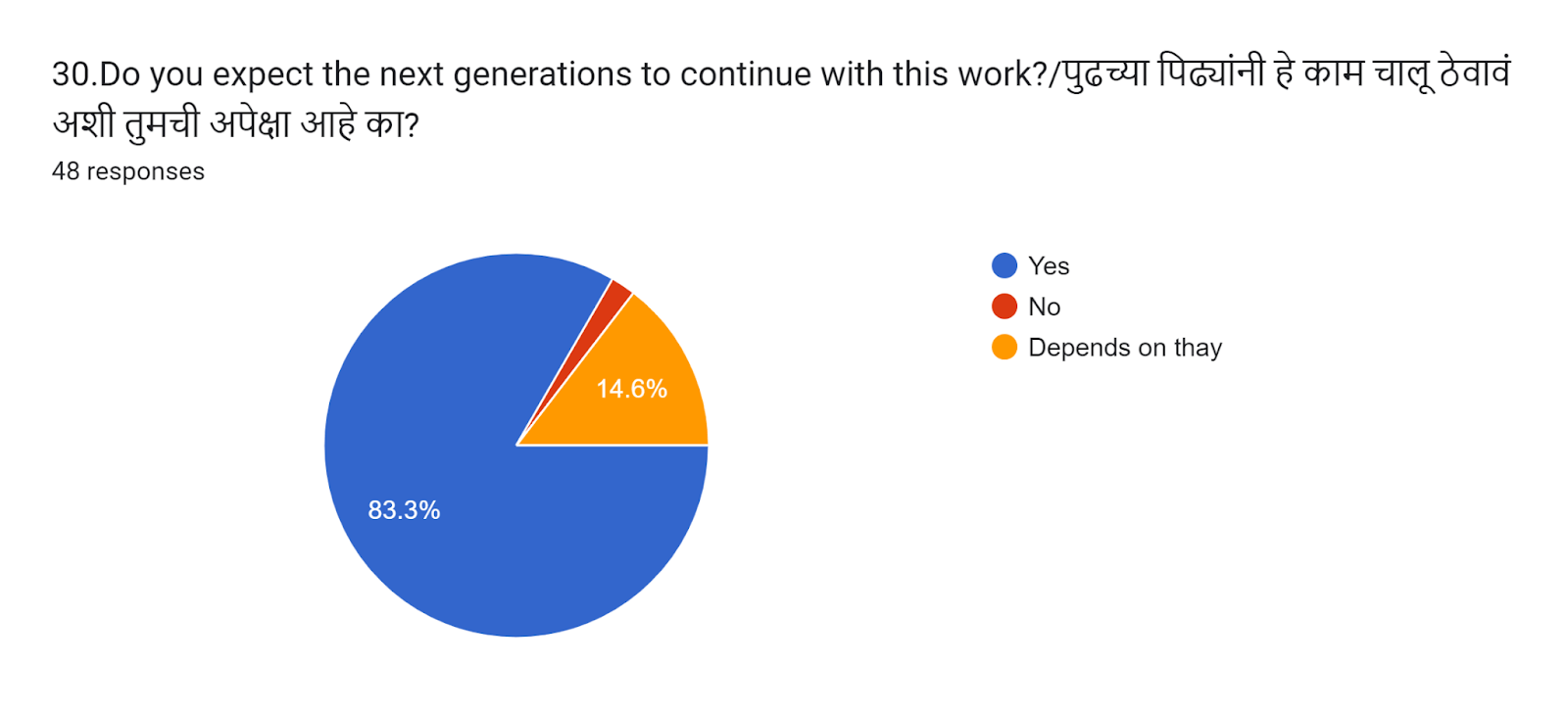
Assumptions: Will the tradition of Ganesh idol making continue in the future generations ?
We were unclear about the situation and hence asked this question.
Findings: A surprising 84% of the artisans were sure that their children would continue this tradition as they are already involved in the activity as a family. The sentiment of the importance of carrying forward the tradition was strong among these. Some of them were aware that the younger generation that had migrated may not be able to continue, especially those who only had daughters
Notes: While this art form has survived for so long as it was a family activity, perhaps now the time has come for it to be extended beyond the family to others who are talented and would like to learn. This will only happen if an income is assured to them.
31. Would you be willing to recycle materials if they are brought back to you after immersion ? (48 responses)
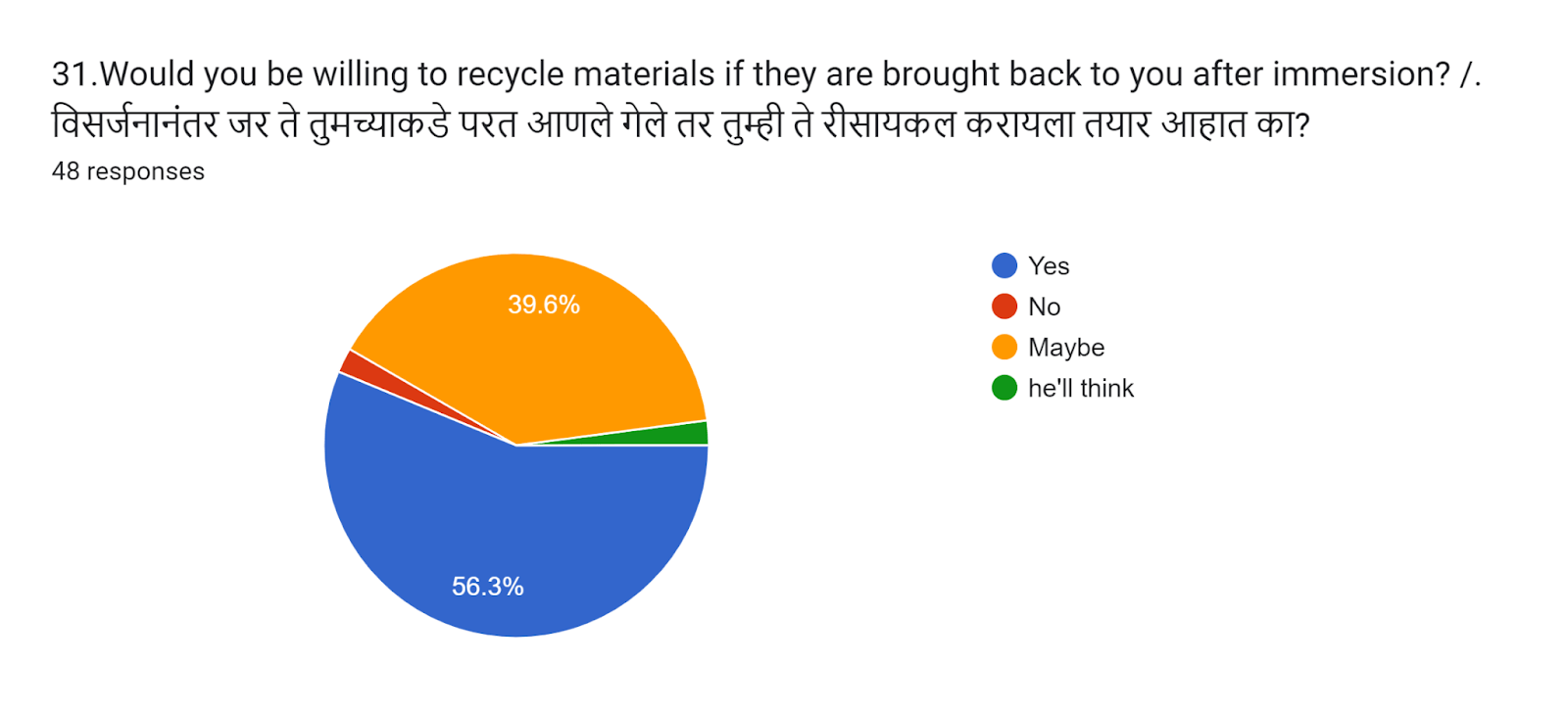
Assumptions: The idea of reusing and recycling material after the ritual is over depends on the creation of a collection system by society at large. However this will only work if there is a willingness among the artisans to put in the labour required to recycle.
Findings: 56% of the artisans agreed immediately , and around 40% were willing to consider it if possible. Some cited sentiments and belief to refuse recycling.
32. What other help would you like from us ? (47 responses)
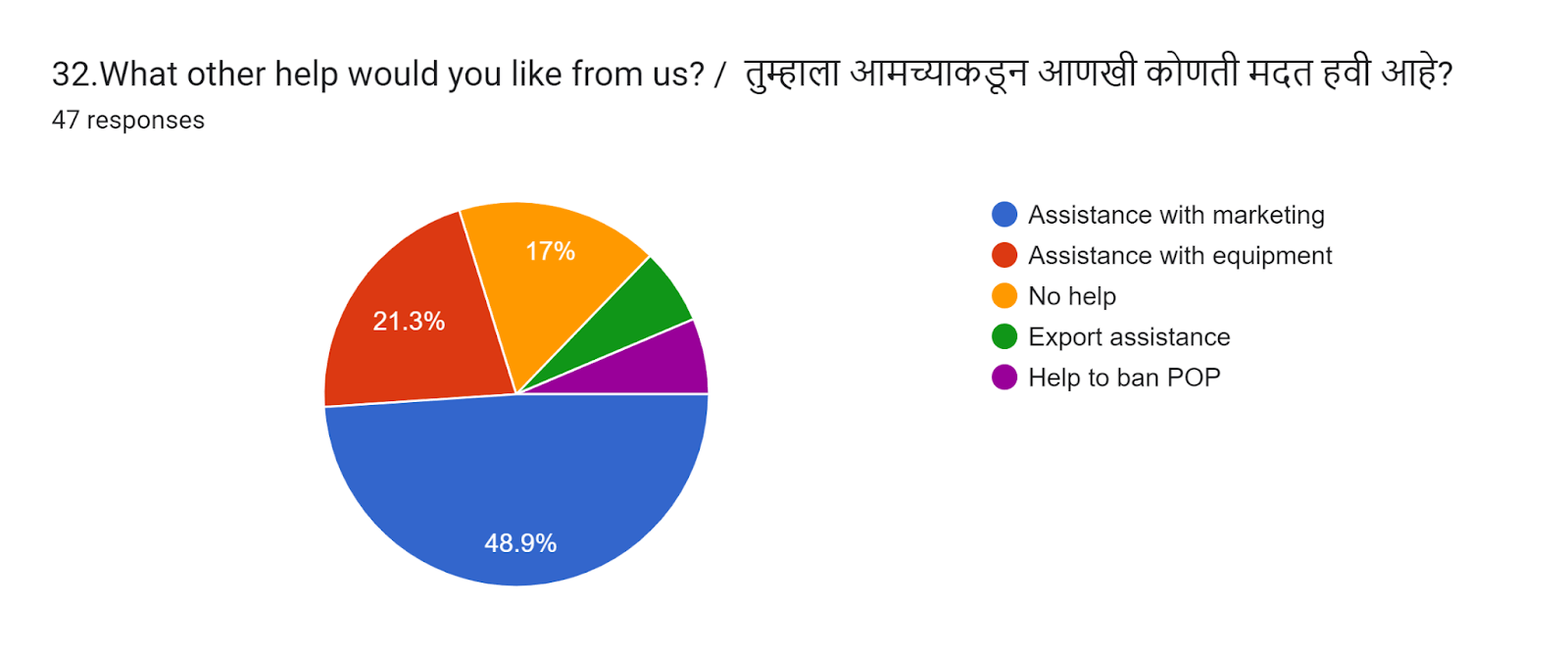
Assumptions: The artisans are an important part of the Indian community as they keep our traditional artforms alive even at a cost to them. Offering them assistance with the shift to more natural materials may reduce the resistance to this shift.
Findings: The main challenge the artisans face is in marketing their idols. Help with raw materials and equipment was also requested. 17% said they did not need help ! Export assistance was also cited. And some finally said that if we could assist them with a full ban on POP that would be best.
Overall Findings
98% of these artisans are carrying on the legacy of traditional generations. 1% of artisans have started a new business because of their passion for the art. While 1% of people do not know the art of making idols from clay, they prepare and sell POP idols by painting them. Chemical paints are used widely with the misconception that as long as they dissolve in water they are eco friendly. The nuances of environmental impacts between various materials are yet unknown to them and their knowledge is limited to what they are told. Details about the immersion guidelines are missing and the government has not taken the effort to do in depth awareness raising on this front. The major push in Sindhudurg is to ban POP completely with most of the artisans and the sanghatanas in favour of such a complete ban.
Recommendations
Artisans
- Artisans are also residents and citizens of the same region where they make and sell the idols in Sindhudurg. This means that any environmental impact of their products will also impact their own lives. Artisans should feel a sense of responsibility and ownership of their natural environment.
- As clay is a nonrenewable resource and also now in short supply, artisans should find ways to conserve the clay.
- Many organizations are training sculptors to make idols from different alternative materials.Sculptors should participate in these and upgrade their skills.
- The chemical paints which are continuing to be used should be replaced with natural pigments.
Sanghatanas
- Most artisans are members of the unions or sanghatanas and rely on them to provide updated information about materials and laws as well as access to the market.
- Sanghatanas should ensure that the accurate environmental information about each material is passed on to the artisan.
- Sculptors should be given more information about the difference between natural colors and artificial chemical colors.
- The reuse and recycling of all materials should be encouraged by the Sanghatana.
- The unions should ensure that the laws passed by the governments are respected by the artisanal community. They should find ways of creating win-win solutions so that both livelihoods and environment are protected.
Government
- The community of idol makers are neither regular sculptors nor artists. Due to this they cannot access the registration schemes of the government. A new category should be created for idol makers, so that they can be registered and avail of government support schemes.
- Women also participate in idol making in Sindhudurg. Schemes like skill development, trainings and grants should be implemented to increase the participation of women in business.
- Although idols are produced from soil which is environmentally friendly, soil is a limited resource. It is necessary to conserve it. The government should implement a mechanism for collection and redistribution of soil after immersion.
- Production of idols from clay requires more manpower. Subsidies to small sculptors to purchase equipment that can reduce labour would help the increase speed of production.
- Government needs to take notice of the sculptors and create and maintain regular communication with them. Proper planning and implementation and regular inspection should be done.
- Pension schemes should be implemented for idolmakers after a certain age.
- Creating a new market by increasing the importance of clay idols and environment among the citizens and ensuring that artisans get guaranteed prices.
Annexure List of Artisans Interviewd
| Name | Village |
|---|---|
| Dasharath Balaram Mestry | Aamrad. 412866 |
| Amol Arun Rane | Halwal ,Kankavli .416502 |
| Rakesh Madhusudhan Patkar | Vadachapat . Malwan 416508 |
| Eknath Shantaram Khadapkar | Malgaon, Sawantwadi. 416510 |
| Swarup Shankar Kasar | Machgaon , Sawantwadi |
| Gangaram Ramesh Manjrekar | zarap . 416510 |
| Hanumat Aatmaram Ghadi | Wayangade |
| Jagannath Chandrakat Rane | Malgaon , Sawnatwadi. 416510 |
| Uday Baburao Raut | Madkhol . Sawantwadi. 416510 |
| Ranjit Krushna Marathe | Kunkeri . Sawantwadi. |
| Narayan Yashwant Sawnat | Majgaon , Sawantwadi |
| Santosh Balkrushna Manerkar | Tulas, Vengurla. 416515 |
| Dattatray Ashok Mathkar | Waingane , Vaingurla 416516 |
| Santosh Vasant Lad | Mankuli, Kudal . 416520 |
| Suraj Anil Mestry | Tendoli. Kudal,416520 |
| Prashant Narayan Ghadigavkar | Ghanwale , Kudal |
| Nandkishor Vasant Mestry | Pokharan . kudal. |
| Swapnil Balkrushna Mestry | Ghavnale , Kudal. 416520 |
| Vaibhav Dnyandev Gawade | Madyachiwadi , Kudal.416520 |
| Mahesh Chandrakant Pedanekar | Kudal |
| Santosh Namdev Tendolkar | Tendoli . 416520 |
| Siddhesh Vilas Sarmalkar | Karamalgaluwadi , kudal |
| Chandrashekhar Baburao Patade | Sukalwad . 416534 |
| Dilip Udaji Dalavi | Talgaon , Malwan 416534 |
| Chandan Chandrakant Kumbhar | Kudal . 416550 |
| Gurunath Balkrushna Mestry | Kudal .416550 |
| Bhiva Lakshman Nandavadekar | Kasal, Karvewadi |
| Sohan Sachin Gothankar | Kasal . 416603 |
| Nandkumar Babaji Chavhan | Kasal |
| Devraj Dilip Nandvadekar | Kasal |
| Ajay Gajanan parab | osargaon . 416603 |
| Ekanath Manohar Pedanekar | Kasal, 416603 |
| Jagnnath Bhagwan Gawade | Chauke , Malwan 416605 |
| Sanjay Lakshman Aambrekar | Aamberi , chauke . 416605 |
| Uday Anant Bhoganvkar | Kumbharmath . 416606 |
| Kiran Mahadev Mitbawkar | Malvan |
| Ankush Pundlik Mestry | Shirgaon |
| Dipak Sitaram Tawade | Torasole, Devagad. 416611 |
| Prashant Jayram Mestry | Aambrad , Kudal 416628 |
| Siddhardh Krushna Mestry | Aambrad, Kudal.416628 |
| Gopal Bala Patgaonkar | Pokharan |
| Satyawan Ganpat Devali | Aamrad. kudal .416628 |
| Abhijit Anant Mandvkar | Rajapur, Kasheli |
| Gurunath Sadashiv Pujare | Devgad Nadan . 416805 |
| Suraj Sakharam Mestry | Oros , Kasal . 416812 |
| Nitin Vaman Anavkar | Anav . Kudal |
| Manohar Krushna Sarmalkar | Oros |
| Vishnu Sakharam Pedanekar | Anav , Patilwadi |
Footnotes
98% of these artisans are carrying on the legacy of traditional generations. 1% of artisans have started a new business because of their passion for the art. While 1% of people do not know the art of making idols from clay, they prepare and sell POP idols by painting them. Chemical paints are used widely with the misconception that as long as they dissolve in water they are eco friendly. The nuances of environmental impacts between various materials are yet unknown to them and their knowledge is limited to what they are told. Details about the immersion guidelines are missing and the government has not taken the effort to do in depth awareness raising on this front. The major push in Sindhudurg is to ban POP completely with most of the artisans and the sanghatanas in favour of such a complete ban.